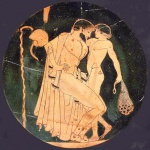Pederastic relationships in history - Post-antiquity to present
| Part of the boylove history series |
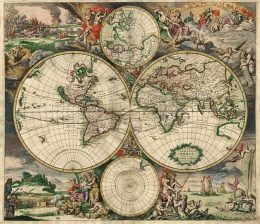 |
| Portal:History |
Over the course of history there have been a number of pederastic relationships between adult men and adolescent boys which have become part of the historical record. In some of these cases one or both members are notable historical figures, while in other cases the individuals involved are only minor personages, often remembered only for this particular aspect of their lives.
Though all of these relationships are by definition homoerotic in nature, the individuals involved do not necessarily identify themselves as homosexuals.[1] The nature of the relationships have ranged from overtly sexual to what is now commonly referred to as platonic , [2] sometimes out of religious principle. [3]
In the pre-modern and modern West, their equivocal status has made pederastic relationships difficult to document, since it was in the interest of both participants to keep the relationship secret. According to historian Michael Kaylor, [S]ince in Victorian England 'homosexual behaviour became subject to increased legal penalties, notably by the Labouchère Amendment of the Criminal Law Amendment Act of 1885, which extended the law to cover all male homosexual acts, whether committed in public or private', expecting 'verifiable data' concerning their unconventional desires is the ultimate scholarly presumption. [4] Another obstacle to the documentation of such relationships has been the destruction of "incriminating" personal and public records, either to "preserve the honor" of the individuals involved, or as retribution against their perceived transgressions.
Nevertheless some of these relationships have become public knowledge, usually because one of the members disclosed it as part of his artistic production, or because the relationship came to the attention of the authorities and the legal record was preserved. In recent years, with the greater public acceptance of homosexual expression, such information has become somewhat easier to come by, especially in those cases where the relationship is no longer illegal.
In the following list the couples are listed in chronological order, and the name of the older partner precedes that of the younger. Although many more men are known to have engaged in such relationships, only those instances in which the name of the younger partner is known are included. In keeping with various traditions which allow (and actually privilege) chaste pederastic relationships, included below are also relationships in which there is evidence of an erotic component even in the absence of actual sexual relations. The more famous partner is usually the older one but not always so.
Ancient and pre-modern Asia and the Middle Ages
- King Mu of Zhou and Jido
- A number of stories associate King Mu with the love of boys . According to one account, he was in love with the youth Jido. When the boy committed a breach of etiquette by stepping over or breaking the king's pillow, he was sentenced to death by some jealous ministers. The king could not totally revoke the sentence, but he reduced it to exile. To ensure his beloved's safety in the wilderness he transmitted to him a secret eight-line verse based on the Lotus Sutra that he had received from the Buddha, which he instructed the boy to recite every day. In order to not forget the verses, the youth wrote them down on chrysanthemum leaves, and did as he was told. As a result, Jido was said to have become an immortal who took the name of Pengzu. [5]
- In another account, his lover is named Ju Citong, "the beloved chrysanthemum child," who drinks the moisture of the flower and gains eternal youth. [6]
- Gong Wei and Wang Qi
- According to 孔子 Confucius , Gongshu Wuren, known as Gongwei, son of King Zhao of 魯 Lu , had Wang Qi as his boy-favorite. Gongwei rode to meet the army of 齊 Qi in his war chariot with his favorite beside him. The two died in battle and their wakes were held at the same time. The people of Lu considered not giving the lad Wang Qi a funeral. They consulted Confucius who said, "If someone can wield the lance to protect his country, how can you not give him a funeral?" [7]
- Gaozu of Han and Jiri
- According to the Historical Records Jiri had no talent or ability, and rose to his position by dint of his looks and grace. [8]
- Emperor Hui of Han and Hongru
- Reigned 194BCE - 188 BCE . Before the tradition of meritocracy took root, male favorites such as Hongru rose to rank and power on the basis of their appealing looks.[9]
- Emperor Ai of Han and Dong Xian
- The Book of Han The Book of Han: Chapter 93 records that the emperor, needing to rise from the bed where his sleeping beloved was lying by his side on top of the emperor's robe, rather than wake the youth cut off the robe's sleeve instead. This gave rise to the term duang xiu, "cut sleeve," that became synonymous with male love throughout Eastern Asia. [10]
- Zhang Hanbian and Zhou Xiaoshi
- The third century Jin Dynasty (265–420) poet's beloved was also an actor whose favors had to be bought. He is described in a poem:
The actor Zhou elegantly wanders
The youthful boy is young and delicate
Fifteen years old. [11]
- Yu Xin and Wang Shao
- The great writer ( 513 - 581 ) was disowned by his beloved upon the latter's rise to power. [12]
- Waliba ibn al-Hubab and Abu Nuwas
- Emperor Tang Xizong and Zhang Langgou
- The emperor gave his young favorite (without whom he "could not sleep peacefully") a horse which the boy put through its paces in the presence of the king, trampling the king's arm in the process. As a result, the king sickened and died shortly thereafter, in 888. [17]
- Muhammad ibn Dawud al-Zahiri and Muhammad al-Saydalani
- Exemplifying the tradition of overwhelming love, a malady known as ʿishq, al-Zahiri, the author of a book on profane love, is said to have died, in 909, of love for the youth al-Saydalani. [18]
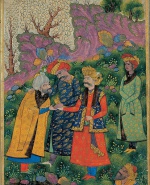
Mahmud of Ghazni and Malik Ayaz
- The two, sultan and slave, are paragons of male love in Islam ic culture. Their story depicts the power of love of a man for a youth, where the king becomes a slave to his slave. Mahmud appointed Ayaz ruler of Lahore in 1021. [19]
- Ibn Ammar and Muhammad Ibn Abbad Al Mutamid
- In 1053 the 19-year-old poet Ibn Ammar was appointed tutor to the 13-year-old future ruler of Sevilla , with whom he promptly fell in love. Separated from the boy by his father, they were later reunited but eventually fell out. Al Mutamid killed his old lover with his own hands in 1086, only to then give him a sumptuous funeral. [20]
- Muhammad Ibn Abbad Al Mutamid and Saif
- "Henri Peres tells us: 'Sodomy is practised in all the courts of the Muluk al-Tawaif. It is sufficient to point out here the love of al-Mutamid for Ibn Ammar and for his page Saif...'" Ibn Warraq, Why I Am Not a Muslim p.342 Of one of his beloved pages Al Mutamid wrote, "I made him my slave, but the coyness of his glance has made me his prisoner, so that we are both at once slave and master to each other. [21]
- Raoul II, Archbishop of Tours and Jean, Archbishop of Orléans
- Raoul appointed his adolescent lover (also known as "Flora") in 1097 to the post in Orléans over the vehement objections of other prelates. [22]
- Ailred of Rievaulx and Simon
- Roger de Pont L'Evêque , Archbishop of York and Walter
- According to John of Salisbury , Roger had been involved with a beautiful boy who, upon growing up, regretted the relationship and blamed the Archbishop, who had the young man tried and had his eyes gouged out. When he persisted with his accusations, he had him tried again and hanged. The scandal broke in 1152, and Roger escaped his deserved punishment through the efforts of Thomas Becket. [25]
- Ibn Sahl of Seville and Mûsâ ibn ʿAbd al-Ṣamad
- Mostly known for his love poetry in muwashshah form, Ibn Sahl two addressees (Muḥammad being the second) are thought by some to represent the two religions that played important roles in his life, his original Judaism and the Islam to which he converted. "Humorous Approach of the Divine in the Poetry of al-Andalus" by Arie Schippers in Representations of the divine in Arabic poetry By Gert Borg, Ed de Moor; p129 Others hold that the youths were historical individuals. [26]
- Alauddin Khilji and Malik Kafur
- Malik, an African slave boy allegedly bought by an Arab trader in Baghdad for 1,000 gold dinars (whence his nickname of Hazardinari) was captured in Gujarat during a military campaign in 1299 by the general Nusrat Khan. He caught the eye of the sultan, was castrated, converted from Hinduism to Islam, and taken by the ruler as catamite. The two were linked by a deep emotional bond, [27] but the excessive love of Alauddin for Malik was blamed for the eventual downfall of the government. Malik, deprecated as being "chopped in front and torn behind," was raised to a position of great power, being appointed in 1306 to the rank of general, a career which he pursued with great success. [28] He had the king's two eldest sons imprisoned and blinded, [29] and when the king died (poisoned by him, according to some) he installed a six-year-old son of Alauddin on the throne and himself as regent. He was decapitated only 35 days later, in 1316, by the same men he had sent to blind the third son of Alauddin, Mubarak Khan . This last bribed the soldiers to spare him, and installed himself as regent upon Malik's death. [30] [31]
- Shihab ad-Din Ahmad and al-Shuhayb
- Ahmad, the son of Al-Nasir Muhammad was summoned from Al Karak to Cairo and married off by his father, who wanted to put an end to the "unsuitable" relationship with al-Shuhayb. Upon his return to Al Karak Ahmad resumed the relationship, disgracing himself by showering the boy with money. The father recovered the money and eventually disinherited his son. Ahmad's own mamelukes eventually murdered al-Shuhayb, leading Ahmad to engage in a series of outrages which resulted in his eventual decapitation in 1345. [32]
15th century
- Filippo Brunelleschi and Donatello
- According to Giorgio Vasari , "And Donatello, then a young man, being held in esteem as a sculptor, Filippo began to hold intercourse with him, and such an affection sprang up between them that it seemed as if the one could not live without the other.[33] In an even earlier account, Giannozzo Manetti holds that "The sculptor Donatello was with him almost all the time." These accounts are seen as reflective of an undercurrent suggesting the two were more than friends. At the time of their first meeting, in Pistoia in 1401, Brunelleschi would have been 24 years old, and Donatello about 15. Their relationship is seen as fitting the typical pederastic model of Florentine male love of the period. Neither ever married, though contemporary accounts see this as related to their dedication to art. However, stories about Donatello's fondness for his apprentices circulated through Florentine intellectual circles, and his David is considered to be a homoerotic work conveying "an undercurrent of personal meaning.[34]
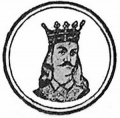
- Mehmed II and Radu cel Frumos
- While a hostage at the Ottoman court in 1445 at the age of eleven, Radu (whose epithet, "cel Frumos" means "the Handsome"), younger brother of Vlad III the Impaler , became the beloved of the Sultan's son, after first refusing his favors, wounding him with his own sword, and spending the night hidden in a tree outside the seraglio, according to Byzantime chronicler Laonicus Chalcondyles. The sultan's son, himself only about three years older than Radu, is said to have prevailed upon the boy by means of presents and kind usage. The relationship lasted many years and Radu was raised to the highest posts in the army.[35][36]
- Marsilio Ficino and Giovanni Cavalcanti
- Ficino lived with the youth at his villa for many years, only separating briefly in 1473, occasion of ardent love letters. [37]
Image:Gian Giacomo Caprotti - Salai.jpg
- Leonardo da Vinci and Gian Giacomo Caprotti da Oreno (Il Salaino)
- An attractive youth with beautiful hair who delighted and exasperated Leonardo ("ladro, bugiardo, ostinato, ghiotto") Salai entered his service in 1490 at 10 and remained for 30 years. His master spoiled the boy with money, food and clothes, and used him as a model for his Saint John the Baptist, a painting related to an erotic charcoal drawing by the artist. Rona Goffen, Renaissance Rivals N85 p. 431 Leonardo's physical and emotional attraction to other males have been identified in his art. His relationship with Salai has been seen as homoerotic since the Renaissance, by such writers as Gian Paolo Lomazzo, Walter Pater and Kenneth Clark who, writing in the 1930s, stated that the relationship between the two was of a kind "honored in Classical times and partly tolerated in the Renaissance." [38] [39]
- Babur and Baburi
- According to Babur's autobiography, some time around the year 1500, In those leisurely days I discovered in myself a strange inclination, nay! as the verse says, I maddened and afflicted myself" for a boy in the camp-bazaar, his very name, Baburi, fitting in.... From time to time Baburi used to come to my presence but out of modesty and bashfulness, I could never look straight at him; how then could I make conversation and recital? In my joy and agitation I could not thank him (for coming); how was it possible for me to reproach him with going away? What power had I to command the duty service to myself? One day, during that time of desire and passion when I was going with companions along a lane and suddenly met him face to face, I got into such a state of confusion that I almost went right off. To look straight at him or put words together was impossible.... In that frothing up of desire and passion, and under that stress of youthful folly, I used to wander, barehead, bare-foot, through street and lane, orchard and vineyard.The Baburnama: Memoirs of Babur, Prince and Emperor
16th century
- Suleiman the Magnificent and Rüstem Pasha
- A Croatian Catholic by birth, Rüstem was taken to Istanbul as a child where he won the Sultan's favor. In adult life he married Princess Mihrimah Sultana, one of the Sultan's daughters, and served the Sultan as general and Grand Vizier , a position which enabled him to accumulate great wealth.[40]
- Benedetto Varchi and Giovanni de' Pazzi
- Varchi's first love affair, around 1525, was with Giovanni, the adolescent son of a local aristocrat. The father had Varchi knifed upon finding his son stole out of the house to spend his nights with his lover. Varchi survived to have other lovers. [41]
- Nicholas Udall and Thomas Cheyney
- Udall, headmaster at Eton College resigned in 1541 after confessing to having "committed buggery" with his pupil, for which he spent a short time in Marshalsea gaol. [42]
- Luigi del Riccio and Francesco (Cecchino) de' Bracci
- Del Riccio, a Florentine merchant residing in Rome, was devoted to Cecchino, a relative of his whom he had adopted and with whom he shared his lodgings. Upon his friend's untimely death he pressed Michelangelo , to whom he was a close friend as well as secretary, to sculpt a likeness of the youth. The master, who did not like to carve portraits, declined, offering instead a sonnet which closes with a rhetorical admonition to the bereaved del Riccio:
If the beloved within the lover shines
Since art without him cannot work alone You must I carve to tell the world of him.[43]
Del Riccio himself expressed his grief in poems:
Look upon my great troubles and my sorrow
Oh, for that goodness, for that desire
That you had to please me, and for that zeal
Of true love between us . . . [44]
- Such frank display of friendship of great men for a mere boy, factored in no small part on the beauty of that boy, was thought by John Addington Symonds to be unimaginable in the modern world, yet not uncommon in the 16th century. [45]
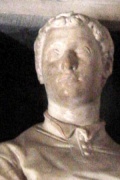
- Michelangelo and Francesco (Cecchino) de' Bracci
- Michelangelo is thought by some to have fallen in love[46] with the cousin and adopted son of one of his closest friends,[47] Luigi del Riccio, himself enamored of the boy, whom they both called idolo nostro, "our idol." The boy lived with del Riccio at the Palazzo Strozzi in Rome[48] and was well known for his charm and good looks.[49] Fifteen at the time of their meeting, he died the following year, on January 8, 1544.[50] His death was much lamented, and many Tuscan poets composed verses in his memory, such as Giovanni Aldobrandini, Carlo Gondi, Fra Paolo del Rosso, and the openly homosexual poet Anton Francesco Grazzini, called Il Lasca.[51][52] Michelangelo composed a sonnet, a madrigal, and 48 funerary epigrams for his and del Riccio's beloved, many if not most at the behest of del Riccio. These are among the poems of Michelangelo bowdlerized after his death by his grand nephew, Michelangelo the Younger, who changed the pronouns from masculine to feminine, making it seem that the poems were addressed to a woman and not to a boy.<[53] At the same time, others regard Michelangelo's and del Riccio's affection for de' Bracci as a Platonic affection on the part of exiled and childless men, the youth becoming an incorporation of their patriotic ideals.[54] A few verses, not intended for publication, allude to physical joys. The last two lines rendered here are an alternative ending to the quatrain, and one which the poet described as "quite moral":[55][56][57]
Qui la carne, ora ridotta a polvere, e le mie ossa
Prive dei begli occhi e della mia bellezza
Rendono testimonianza a colui a cui portai grazia nel letto,
Che abbracciavo, e nel quale la mia anima continua a vivere.
The flesh, now earth, and my few bones, now ridden
Of my sweet eyes and of my pleasing sight,
Remind the one to whom I was grace in bed
Whom I embraced and in whom my soul still lives.
- Pope Julius III and Cardinal Innocenzo Ciocchi Del Monte
- the 16th-century historian Onofrio Panvinio asserted that Julius was "puerorum amoribus implicitus" (entagled in the love of boys).[58] The future pope "picked up" (the phrase is used by the Catholic Encyclopedia) the illiterate 13 or 14-year-old street urchin in 1547, and the resulting scandal almost cost Julius the election to the papacy, becoming a staple of anti-papal polemics for over a century. Innocenzo was 17 when Julius became pope in 1550, and despite the boy's evident unsuitability for high office Julius' first act was to raise him to the rank of cardinal, with benefices which made him one of the richest individuals in Europe. Julius, awaiting Innocenzo's arrival in Rome to receive his cardinal's hat, "showed the impatience of a lover awaiting a mistress", and boasted of the boy's bedroom prowess. Gossip called the boy Pope Julius' "Ganymede," and the Venetian ambassador reported that Innocenzo shared the pope's bed. Innocenzo fell out of favour with the Church after his patron's death, and was buried beneath an unmarked slab beside the del Monte chapel at the church of San Pietro in Montorio, Rome - Julius himself is buried inside the Vatican, not far from the tomb of John-Paul II.[59] to each other, as well as of the ignominy that attended Innocenzo.[60][61]
- Theodore Beza and Audebert
- Among his 1548 Juvenilia poems was one which was understood to point to his bisexuality , in which he compared his passion for two young lovers, "little Candida" and "little Audebert," concluding he loved Audebert the best. Later this poem would be held against him in particular and against Calvinists in general as a proof of moral failing. [62] [63]
- Benedetto Varchi and Giulio della Stufa
- Giulio, the subject of many passionate letters around 1552, complained to his teacher to send fewer letters and more subdued in language, since his father had read one and exclaimed, "This is nonsense! What kind of love is this?" [64]
- Marc Antoine Muret and Memmius Frémiot
- The two lovers had to flee Toulouse in 1554, where they were later burned in effigy as sodomites. Muret and his young pupil had been warned of the danger by a friend in parliament who sent him only a verse of Virgil : "Oh, flee this cruel land, flee the bitter shore." [65]
- Carlo Carafa and Ascanio
- In 1555 the poet Joachim du Bellay composed a sonnet to the recently deceased Ascanio,
Ascanio, whom Carafa loved more than his eyes,
Ascanio, the beauty of whose face surpassed
The handsome Trojan cupbearer who pours for the gods" [66]
- Benvenuto Cellini and Fernando di Giovanni di Montepulciano
- In 1556, when Cellini dismissed his apprentice, the latter denounced the sculptor, according to the trial records, for having: "Cinque anni or sono ha tenuto per suo ragazzo Fernando di Giovanni di Montepulciano, giovanetto con el quale ha usato carnalmente moltissime volte col nefando vitio della soddomia, tenendolo in letto come sua moglie." (For five years or so he kept as his boy Fernando di Giovanni di Montepulciano, a youth whom he has used carnally numerous times via the abject vice of sodomy, keeping him in bed as his wife.[67][68][69] Cellini was convicted, had to pay a fine of 50 gold scudi, and was sentenced to four years in jail, later commuted to house arrest.[70]
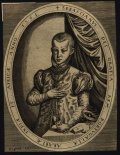
- Father Luís Gonçalves da Câmara and Sebastian of Portugal
- The young king came down with discharges at the age of ten in 1564, thought to be the result of sexual relations with Câmara, his confessor, who was accused of wanting to gain control of the young king's mind after having gained control of his body. The young king's close relationship with his confessor continued for the rest of his life.[71]
- Shah Hussain and Madho Lal
- The love of Shah Hussain, a Punjabi weaver, for a Brahmin boy called "Madho" or "Madho Lal" is famous, and they are often referred to as a single person with the composite name of "Madho Laal Hussain." A mystic poet and talented musician, his love for the Madho is seen as a stepping stone to his fana, absorption in God. The culmination of their relationship was the conversion of the Hindu Madho to Islam. Today Shah Hussain is one of the major patron saints of Lahore. Madho's tomb lies next to Hussain's in the shrine.[72]
- Luigi Fontino and Luigi Dalla Balla
- In Loreto in 1569 and 1570, Dalla Balla, an orphan choir boy of fifteen or sixteen, slept with a series of older monks, canons and musicians. Fontini, the canon of it:Santuario di Nostra Signora di Loreto was denounced. Put in irons for two months and promised lenience, he finally confessed. He explained his sexual involvement with the youth by claiming that "I thought to have a disciple who could take care of me if I became ill in my old age. He was defrocked, turned over to the town authorities, and decapitated. The boy was flogged and exiled from the Papal states.[73][74]
- Giovanni Leonardo Primavera and Luigi Dalla Balla
- Primavera, at the time a musician and composer 25 to 30 years of age, was one of the lovers of the choir boy Dalla Balla. The latter confessed that he had been sodomized while asleep by Primavera. The composer escaped by sea back to Venice, avoiding the punishment which the local authorities wanted to inflict on him. Dalla Balla went on himself to a career in music, in Venice.[75]
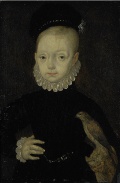
- Esmé Stewart, 1st Duke of Lennox and James VI, King of Scots, later James I of England
- The 13-year-old monarch fell in love with his 37-year-old French cousin as soon as they met, and was under the older man's influence for several years. Stewart was the first of many favorites, and their relationship was a cause for profound concern both in Scotland and in England.[76]
- Anthony Bacon and Isaac Burgades
- While living in Montauban in 1587, the elder brother of Francis Bacon was convicted of sodomy with a page who at the trial declared that "there was nothing wrong with sodomy" and that "Theodore Beza of Geneva approved of it."[77] The two escaped conviction and probable death by burning only due to the intercession of Henry IV of France.[78]
- Prospero Farinacci and Berardino Rocchi
- The Italian lawyer and judge, noted for his harsh sentencing of sodomites, was himself accused in 1595 of repeated sexual relations with Berardino Rocchi, a 16-year-old page in the Altemps palace, where Farinacci lived. He was excused of the crime by Pope Clement VIII, who famously made a pun of Farinacci name (which alludes to "flour" in Italian) by claiming that "The flour is good but the bag it's in is not so clean." [79]
- Pascual Jaime and Francisco Legasteca
- Pedro de León, chaplain at the Royal Prison of Seville, compiled records between 1578 and 1616 on 50 prisoners accused of sodomy, all of whom were eventually executed. Among them was Pascual Jaime, chaplai?n to the Duke of Alcalá. Jaime was in the habit of picking up destitute young men off the street, feeding and clothing them and keeping them in his house. Having attracted the attention of the authorities for his elegant attire and retinue of painted and garbed youths, he was caught with one of them in flagrante delicto. Under torture Jaime confessed to a lifetime of sodomy. The authorities showed no mercy to Legasteca, his partner despite the fact that he was very young and "cried like a boy." Both were publicly burned at the stake, within days of each other.[80]
17th century
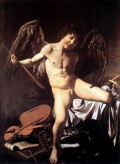
- Caravaggio and Francesco ('Cecco') Boneri
- The youthful Cecco modelled for many of Caravaggio's most famous paintings, including his 1602 Amor Vincit Omnia, and may be the artist known as Cecco del Caravaggio.[81]
- James I of England and Robert Carr, 1st Earl of Somerset
- The 41-year-old king fell in love with the 17-year-old ex-page at a 1606 jousting bout. Their love lasted several years, though as the boy matured the king was powerless to prevent Carr's “creeping back and withdrawing yourself from lying in my chamber, notwithstanding my many hundred times earnest soliciting you to the contrary.”[82]
- Théophile de Viau and Jean-Louis Guez de Balzac
- The 22-year-old Théophile de Viau met the 15-year-old future author in his native Angoulême in 1612[83][84][85] The two became lovers and traveled together around 1613 in the United Provinces, eventually ending up at the Leiden University, where they enrolled as students in May of 1615. In Holland, Balzac is beaten with a stick, affront avenged by Viau with the sword. However Balzac is debauched and ungrateful and they later exchanged bitter recriminations.[86] Prefiguring the relationship between Verlaine and Rimbaud, they brawl upon their return later that year, an event which marks the end of their affair.[87][88]
- Francis Bacon and Godrick
- According to the Puritan moralist Simonds d'Ewes, Bacon, after his fall from power in 1621, released most of his servants but "kept still one Godrick, a very effeminate-faced youth, to be his catamite and bedfellow."[89] [90] He also had a relationship with another servant, a certain "bloody Percy" according to Bacon's mother. Bacon bequeathed a legacy of £100 to Henry Percy.
- Mohammed Sa'id Sarmad and Abhay Chand
- Sarmad, a Persian Jew born in a rabbinical family, converted to Islam and became a Sufi. Deciding in 1631 to travel to India as a merchant, he was possessed by love (ishq) for Abhay, a Hindu boy in Thatta. He forgot his self, he abandoned wealth, he set aside his clothes and wandered around naked. He is said to have sat at the boy's doorstep, composing poems of love. The boy's father saw that Sarmad's love was pure and allowed him to enter. The two lovers became so attached they could not live apart. Abhay became Sarmad's disciple, whom he instructed in a mixture of Judaism and Islam. Later the two traveled to Delhi where Sarmad became spiritual adviser to Dara Shikoh, the heir presumptive to Shah Jahan, the fifth Mughal emperor. In 1661 Sarmad was accused of apostasy and beheaded at the orders of Aurangazeb. Some of his letters and quatrains survive him.
- Murad IV and Musa Çelebi
- During a Janissary mutiny in 1631 the rebels demanded the head of the Sultan's trusted beloved. To protect the boy the Sultan gave him over to two of his officials, one of them his brother in law, named Rescheb. These two however delivered him to the mutineers, who murdered the boy. Murad found an excuse and had Rescheb executed, and six months later the Sultan avenged himself on the mutineers, killing 20,000 of them.[91][92]
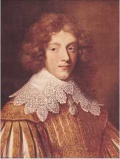
- Louis XIII and Henri Coiffier de Ruzé, Marquis of Cinq-Mars
- Cardinal Richelieu introduced the 17-year-old marquis to his king in 1637, thinking the youth would be easy to control. Cinq-Mars was appointed Master of the King's Wardrobe on his birthday, March 27, 1638. Later, the marquis tried to convince the king to have Richelieu executed, and induced some French nobility into revolt, but the effort failed and Richelieu had him beheaded in 1642.[93][94]
- Qi Zhixiang and Abao
- Qi, the Imperial Military Inspector in Ming China in 1642 had a boy lover by the name of Abao, who "was pretty like a little girl" yet coy. A seasoned actor, he would refuse to approach his admirers, a tactic that would create a genuine homosexual appeal based on his control of tension, reversal, suspense and discovery. Qi went through a number of hardships with Abao, with whom he was obsessed.[95][96]
- Cardinal Antonio Barberini and castrato Marc'Antonio Pasqualini
- The famous castrato singer Marc Antonio Pasqualini was believed in 1630s and in the early 1640s to have been a lover of his protector Cardinal Antonio Barberini, nephew of Pope Urban VIII. Certainly Pasqualini acquired very strong position at the cardinal's court and was granted the control over the expenditure of large sums and over the access to the cardinal himself[97]. Cardinal Barberini, who, as was said at the time, was involved in the several affairs with both male and female lovers[98], after the fall of his family (1645) changed his dissolute lifestyle, devouted himself to religion and in 1653 was ordained to the priestehood[99].
- Cyrano de Bergerac and Claude-Emmanuel Lhuillier, dit Chapelle
- Charles Coypeau d'Assoucy and Claude-Emmanuel Lhuillier, dit Chapelle
- D'Assoucy and Chapelle fell deeply in love. As d'Assoucy later recalled: "I could not live without him, and he could hardly live without me.[101]
- Harmen Meyndertsz van den Bogaert and Tobias
- Van den Bogaert, Dutch doctor, explorer and commander of Fort Orange, a married man with four children,[102] was caught flagrante delicto sodomizing Tobias, his black boy slave, in late 1647.[103] Van den Bogaert and Tobias escaped and fled to the lands of the Mohawk. Tobias was caught a few days later, and shortly thereafter van den Bogaert too was captured and brought back to Fort Orange, from where he escaped again in early 1648. As he was being chased across the North River branch of the Hudson River he fell through the ice and drowned.
- Charles, marquis du Bellay, and Richard de la Monnerie
- Du Bellay, when already of an advanced age and hunchbacked obtained in 1661 his young valet in exchange for 50 louis d'or from the soon to be notorious Jacques Chausson, who ended his days on a pyre for various sodomitical acts. The marquis, also known as the Prince of Yvetot, died without issue, thus extinguishing the line.[104]
- Molière and Michel Baron
- Molière met the young actor, with whom he fell in love, in February of 1666. He hired the boy into his troupe and had him live in his house, a matter that created conflict with Armande, Molière's young wife. Gossip had it that Baron eventually cheated on Molière, just as his wife had done.[105][106]
- Henry III of France and Anne de Joyeuse
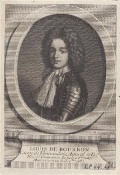
- Philippe de Lorraine and Louis de Bourbon, Count of Vermandois
- Louis, the 14-year-old bastard son of Louis XIV , fell into royal disfavour in 1682 upon discovery of his membership in a secret homosexual society at court, named "The Sacred Fraternity of Glorious Pederasts," and of his relationship with the lover of Philippe I, Duke of Orléans known as Monsieur, the king's brother. He was publicly whipped in front of the anti-sodomitical king and was exiled from the court. A year later he was given the chance to redeem himself at the siege of Courtray. Ill with a high fever, he joined the battle despite the advice of the royal physician, and succumbed to the disease shortly thereafter. The king did not mourn him. [109] [110]
- Jean-Baptiste Lully and Brunet
- In 1685 the 53-year-old composer was denounced for his dalliances with his young page, who was said to be lovelier than Cupid, and who had been preceded by another boy, Lafarge.[111] Brunet, punished by being confined to the Saint Lazare monastery, confessed to Roman orgies involving so many of the great lords that all was hushed up.[112][113]
- William III of England and Arnold van Keppel, 1st Earl of Albemarle
- By birth a Dutch nobleman, van Keppel became page of honor to William III in his mid-teens, possibly as early as 1685.[114][115] According to some, he was already William's lover by the age of 16.[116] Keppel accompanied William to England in the Revolution of 1688, though others assert that his affair with the king began later in life, possibly at the time of a hunting accident when he is said to have drawn the king's attention for his uncomplaining demeanor upon breaking his leg.[117][118] Public commentary on the king's relationship with him intensified in 1692 when van Keppel began to receive grants of land from the king.[119] He became Groom of the Bedchamber and Master of the Robes in 1695. In 1696 he was created Baron Ashford of Ashford, Kent, Viscount Bury in Lancashire. In 1699 he was awarded the command of the First Life Guards,[120] and on February 10, 1697 William made van Keppel Earl of Albemarle, Viscount Bury and Baron Ashford. Sent by the ill king to the Netherlands in February 1702, he returned just in time to receive William's last commissions on his deathbed, including being entrusted with the king's private papers.[121]
- Gian Gastone de' Medici, Grand Duke of Tuscany and Giuliano Dami
- Struck by the looks of the Marquess Capponi's young servant, the Duke requested the 14-year-old boy and took him along as lackey and lover on his voyage to Hamburg in 1697. Later the boy would act as procurer, providing the Duke with over 300 young lovers who were known as the "ruspanti," after the ruspi, coins with which they were paid for their services. Gian Gastone's intimate relationship with Dami was the most important of his life.[122]
18th century
- Hans Hermann von Katte and Frederick II of Prussia
- The 18-year-old crown prince Frederick sought to flee his brutal father in 1730, together with his 26-year-old lover. Betrayed, they were caught, von Katte being sentenced by the king to be executed before his friend's eyes. At the execution Frederick called out, "Pardonnez moi, mon cher Katte," (Forgive me, my dear Katte!) "La mort est douce pour un si aimable Prince," (Death is sweet, for such a kind prince,) came the answer.[123]
- Luc de Clapiers, marquis de Vauvenargues and Paul Hippolyte Emmanuel de Seytres
- "So thus I was destined to outlive our friendship, Hippolyte, when I had hoped that it would ease all the evils and the sorrows of my life until I had drawn my last breath!"
- He entered the army as sub-lieutenant in the king's regiment, and served for more than ten years, taking part during the War of the Polish Succession in the Italian campaign of Claude-Louis-Hector de Villars in 1733, and in the disastrous expedition to Bohemia in support of Frederick II of Prussia 's designs on Silesia , in which the French were abandoned by their ally.
- There, in 1740, he met and fell in love with Paul Hippolyte Emmanuel de Seytres, the eldest son of the Marquis of Caumont, born August 13th, 1724. De Seytres died two years later, during the Siege of Prague in April of 1742, at the age of seventeen. Oeuvres de Vauvenargues, Volume 1 By Vauvenargues; p141 De Clapiers addressed his philosophical work Conseil à un jeune homme (Advice to a young Man) to his young beloved. He also wrote a funeral eulogy for him, a work which he considered to be among the most important of his life, and which he continued to polish until his death. Vauvenargues discusses in his writings his hate of women and his love of young men, which he defends as having nothing against nature, and blames "malicious spirits" for criminalizing his tastes in love. [124]
- Both were officers in a French regiment that fought in Bohemia since 1740. Hippolyte, the oldest son of the Marquess of Caumont, born August 13, 1724, was 16 when they met[125] and 17 when he died, during the Siege of Prague in April of 1742. De Clapiers, nine years older than his young friend, addressed his philosophical work Conseil à un jeune homme (Advice to a young Man) to Hippolyte de Seytres. "He understood all the passions and opinions, even the most singular, that the world blames." —Vauvenargues about his friend.[126]
- Mustafa III and Silahdar Mehmed Paşa
- Captain Robert Jones and Francis Henry Hay
- Jones was sentenced in 1772 to hang for sodomy with the 13-year-old boy in 1761, but his fellow officers petitioned the king and he was pardoned at the last minute by George III to the outrage of the City notables.[128][129][130]
- William Thomas Beckford and William Courtenay, 9th Earl of Devon
- Beckford, 19, fell in love with Courtenay, 10, nicknamed Kitty and "one of the most beautiful boys in England," in 1779, a relationship which lasted a number of years. Both pursued lifelong involvement with boys. In a letter to Courtenay's aunt he describes his feelings: "You know, he was never so happy as when he reclined by my side listening to my wild musick or the strange stories which sprang up in my fancy for his amusement. Those were the most delightful hours of my existence."[131][132]
- Georg von Pasterwitz and Franz Xaver Süssmayr
- It has been speculated that Süssmayr was homosexual. At the age of 14 he became the favorite pupil, and possibly beloved, of von Pasterwitz at Kremsmünster Abbey, where he was teaching music, and the two remained lifelong friends.[133]
- William Thomas Beckford and Dom Pedro, Marquis of Marialva
- While in Portugal in 1787 where he had taken refuge after his affair with Courtenay had become a public matter, Beckford entered into a relationship with the 15-year-old son of Marialva. The young marquis' father remained quite fond of Beckford, hoping to effect a marriage between Henriqueta, his illegitimate daughter, and the rich Englishman.[134][135]
19th century
- Ali Pasha and Athanasi Vaya
- Cheng I and Cheung Po Tsai
- Cheng I was a pirate of the Chinese coast, who kidnapped the 15 years old Chang Pao in 1801. Chang Pao later became the leader of Cheng's pirate fleet.[137]
- Matthew Lewis and William Kelly
- Lewis, a member of Parliament and the author of "Monk" an early Gothic novel, in 1802 fell for the fourteen year old son of Isabella Kelly, herself an author of Gothic novels. The boy was wild and unfaithful, despite which Lewis bequeathed him a large sum. Their love affair became widely known scandal.
- Lord Byron and Nicolò Giraud
- Lord Byron fell in love with the French-Italian lad in 1810, when the boy was 15.[138] "It is about two hours since, that, after informing me he was most desirous to follow him (that is me) over the world, he concluded by telling me it was proper for us not only to live, but 'morire insieme'. The latter I hope to avoid - as much of the former as he pleases."[139] Byron wrote to a friend that he and the boy were having anal sex (in code, "the Pl. & opt. C." short for "coitum plenum et optabilem").[140]
- Franz Desgouttes and Daniel Hammeler
- Daniel moved in with his 25-year-old lover, a Swiss lawyer, at the age of 16 in 1810, and lived with him for seven years, until he was murdered by Franz in a fit of jealousy. His lover was executed by being broken on the wheel, an event that galvanized the early Swiss homosexual emancipation movement.[141]
- John Hepburn and Thomas White
- The two lovers were hanged for sodomy at Newgate on 7 March 1811, though Hepburn protested his innocence to the bitter end. The elder was a 46-year-old ensign in the British Navy, the younger a 16-year-old drummer boy.[142] They were "launched into eternity" before "a vast concourse of spectators among whom were numbered members of the royal family."[143] Their relationship had come to light as a result of the Vere Street scandal.
- Ludwig van Beethoven and Karl van Beethoven
- In 1815, when the boy was nine years old, his father died and Beethoven began a five year battle to gain custody of his nephew from his sister in law, a woman he judged morally unfit to raise him. His domination of every aspect of the boy's life became so overwhelming that Karl, at the age of twenty, attempted to take his own life with a bullet to the head. He failed, and was nursed back to health by his mother.
- His subsequent departure in order to join the army sent the uncle into a depression which is thought to have precipitated his death, shortly thereafter.
- Among Beethoven's papers there were a large number of Conversation Books, notebooks that he began using in 1818 when his hearing had deteriorated to the point where he could no longer carry on a conversation. In these books were recorded the exchanges between the uncle (who had gone deaf) and his nephew. Of course, they only contain the words of the nephew. and falsified entries in the remaining ones.
- between Beethoven and his nephew, the one person with whom he had his most important emotional relationship, are clear proof that the topic of the discussions between the man who never married and the boy he loved and over whom he obsessed was of such a nature as to be unprintable in the nineteenth century. Beethoven's biographer, Anton Felix Schindler, destroyed 264 of the
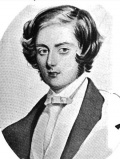
- Edward FitzGerald and William Kenworthy Browne
- FitzGerald, a man who exhibited no sexual interest in women, at the age of 23 met Browne, 16 at the time, who became the dearest of all his many friends. Their friendship, on FitzGerald's part "a celibate but long and ardent attachment," continued until Browne's death in a riding accident in 1859. The poem Euphranor: A Dialogue on Youth was a glorification of Browne.[144][145][146][147]
- Ranjit Singh and Hira Singh
- The Maharaja, described by Richard Francis Burton (based on an account by fr: Victor Jacquemont) as a "man of pederastic morals,"[148] was in love with the son of Dhyan Singh,[149] one of his more powerful ministers. In 1838 Hira Singh was described as “a handsome boy, loaded with emeralds and pearls.”[150] Ranjit could not bear rto be apart from him for long, and allowed only him to sit in a chair, while other courtiers either stood or sat on the floor.[151] Later Hira Singh gave proof of both wisdom and courage[152] but survived his lover by only five years, being killed by the Sikh army in December 1844.[153]
- Edward John Eyre and Wylie
- The Australian explorer met Wylie in 1840 and took him as companion, together with two other Aboriginee boys and a European, on his 1841 expedition across the Nullarbor Plain. Afterwards he formed repeated close associations with such boys.[154]
- James Brooke and Charles (Doddy) Grant
- Brooke, Rajah of Sarawak, a man uninterested in women and with a penchant for falling in love with adolescent boys, fell in love in 1848 with a young recruit, Charles Grant (grandson of the seventh Earl of Elgin), 16 at the time. His love was reciprocated by the boy.[155]
- Charles John Vaughan and Alfred Pretor
- Vaughn, headmaster at Harrow School, in 1851 was engaged in a long-standing love affair with Pretor, the head boy at the school, a youth known as "the house tart."[156] Pretor boasted of the affair to his friend, John Addington Symonds. The latter eventually divulged matters to his father who blackmailed Vaughn into resigning. Pretor never forgave John his indiscretion.[157]
- John C. Frémont and Jesse Shepard
- The adventurer and politician took on the 13-year-old boy as his page, a role he filled for two years, until 1863. Jesse had been chosen because he was queer, and the two were constantly together.[158]
- Émile Petitot and Baptiste
- While posted on a mission to the Chipewyan nation in the early 1860s, Father Petitot "formed an excessive attachment" to a young native boy who worked for the mission. Bishop Grandin determined that things had gone too far: He had in his possession an intimate letter from Petitot to Baptiste, and Father Petitot had committed "indiscretions." He sent Father Petitot to take over the mission at Fort Resolution, where one of the Father's first acts as director was to ask Grandin to transfer the boy to his station. Grandin refused, citing Petitot's "fatal attachment to a child." Two years later Father Petitot was assigned to Fort Good Hope, where it became known among the traders and the natives that Father Petitot' preferred lover (though not the only one) was a 15-year-old native boy in the employ of the mission.[159]
- John Addington Symonds and Norman Moor
- Symonds was introduced to the schoolboy in 1868 by a common friend, and for Norman's sake sought an appointment as teacher at his school, Clifton College.[160]
- Peter Ilich Tchaikovsky and Eduard Zak (Sack)
- In 1869 the 29 year old T. fell in love with Eduard, a fifteen year old student at the Moscow Conservatory, a cousin of another pupil of Tchaikovsky's at that school, Rafael von Koeber. The passionate affair inspired the love theme in the tragic and romantic Romeo and Juliet Fantasy Overture, composed that same year.
- Two years later young Zak was working for Tchaikovky's brother Nikolay, whom he had persuaded to hire Zak and to whom the composer addressed a letter asking him to send Eduard to Moscow because
- "I have missed him a great deal and I am fearful for his future. I fear that manual work will kill all higher aspirations in him. [161]
- Zak did come to Moscow shortly thereafter and the two spent time together. On Novermber 2nd, 1873 at the age of nineteen, Eduard committed suicide. After his death Tchaikovsky writes,
- "At this moment I am affected by the tragic catastrophe that has befallen a man who was very close to me, and my nerves are tremendously shaken. I cannot do anything in this state." [162]
- In his journal of 1889, T. reminisces about his feelings for the boy and the reproaches made him at the time of his death:
- "How amazingly well do I remember him: the sound of his voice, his movements, but in particular, the uncommonly wonderful expression at times on his face. I cannot conceive that he is not here at all. His death, that is his complete non-existence, is beyond my comprehension. I think I never loved anyone as much as him. My God, but what did they not say to me then - and however much I soothe myself, my guilt before him is terrible! And yet I loved him and I love him still, and the memory of him is sacred to me."
- T. Jackson in his book on the 6th Symphony labels T a "pedophile" and notes that suicide is not unusual in the cases of children damaged by the sexual depredations of adults. However, it seems more reasonable to conclude that a nineteenth century youth in his mid-teens was anything but a child, being just one year shy of the age of consent in today's Russia, and living in an age when youths matured faster than today. Thus his tragic death can be attributed not to some putative abusive behavior by the composer, a moral man who was well loved by his young lovers, but more likely to the hostility and contempt that preyed on any love affair between males in those days, and to the irresolvable conflict between religious dogma and emotional truth. Tchaikovsky's insistence on living an authentic love life is thought to have claimed his own life, as well as that of another of his youthful lovers, his nephew Bob Davydov, who spent much of his life after Tchaikovsky's probable suicide creating a museum to the dead composer, and who took his own life at the age of 34 in 1906.
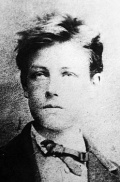
1871
- Paul Verlaine and Arthur Rimbaud
- Henry Morton Stanley and Kalalu
- Stanley was in love with an African boy whom he took along on his travels to England and America in 1872,[165] and about whom he wrote a book, "My Kalalu."
- Reginald Brett, 2nd Viscount Esher and Ernlé Johnson
- Inspired by his tutor and close friend William Johnson Cory, Brett engages the 15-year-old Ernlé in a romantic but chaste mentorship of many years duration starting in 1874.[166]
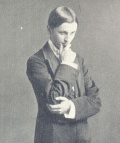
- Oscar Browning and George Nathaniel Curzon, 1st Marquess Curzon of Kedleston
- Nikolai Przhevalsky and Fyodor Eklon
- Eklon, who was taken on at the age of 18, was one of a series of youths and young men who accompanied Przhevalsky on every one of his expeditions. A confirmed bachelor, Przhevalsky demanded absolute loyalty from his young acolytes, and they also had to share his tent. Eklon lasted for eight years, from 1875 to 1883, when he announced to Przhevalsky that he was planning to get married. That caused a passionate quarrel and an irremediable break between him and his mentor, who hated women.[171][172]
- Jules Verne and Aristide Briand
- Some historians and literary critics have detected certain pederastic elements in the life and work of the writer. Jean Paulhan, in an introduction to a work written in the nineteen sixties but still seen as important,[173] describes two main themes identified in Verne's work. First, that "in life we must, little by little, substitute in place of our natural father an older and better man than ourselves," and later that we will need likewise to substitute, in place of our wife, a male friend worthy of esteem and admiration. The second theme is that "the entire opus of Jules Verne has, as its purpose and secret, pederasty."[174] His theme is picked up by a later work, that of Marc Soriano, who sees elements of "latent homosexuality, sublimated pederasty, misogyny" in Verne's writings.[175][176]Verne's close and lasting friendship with Aristide Briand, whom he met in Nantes in 1876 when the young man was a fifteen year old lycéen and schoolmate of his son Michel, is also cited as a possible example of his attraction to youths.[177] He frequently picked up Briand from the lycée and brought him to his house, and also used him as a character in A Long Vacation.[178] Michel Larivière, in his Homosexuels et bisexuels célèbres posits a quasi-universal theme in the novels of "an older and more experienced man who offers support and affection to a young and very handsome boy." Examples of such pairs are Lord Glevanan with the young Robert Grant, in The Children of Captain Grant, the dashing Pencroft with the fifteen year old Herbert Brown, the "brave boy" whom he "loved as if he had been his own child," in The Mysterious Island, and Kaw-djer and Halg in The Survivors of the 'Jonathan,' of whose love he writes:
Another indication of Verne's pederastic or homosexual leanings has been suggested in his purported lack of tolerance for women, who are largely absent from his works, or reduced to insignificance, or subjected to a ferocious misogyny. Likewise, the incident of the attack by his nephew, with whom he had entertained a long term and affectionate relationship, and which was hushed up by the local press, is held to be indicative of either a sexual relationship gone bad, or else an attack of jealousy at the arrival of a new love interest.[180] In a recent biography, his translator, William Butcher, in presenting evidence for Verne's homosexual leanings, also cites the fact that he only fathered one child, spent large periods of his life and both major journeys in the company of his close friend, the composer Aristide Hignard who was probably homosexual himself, and spiced up his letters to Hetzel with double-entendres about oral sex.[181] Verne, in his youth, established a weekly dining club, the "Onze-sans-femme" (The Eleven wife-less ones). Of the group, he was the last to get married. In 1898, towards the end of his life, he burned all his private papers and gave away most of his personal possessions, presumably to throw future researchers off the track.Halg was the only one able to move this disaffected man, who knew no love other than the one he felt for a child... Is it because they have some dim notion of this disproportion that, despite its resplendent beauty, such an emotion astonishes more than it charms other men, and seems inhuman to them, even though it is above them?[179]
- Some historians and literary critics have detected certain pederastic elements in the life and work of the writer. Jean Paulhan, in an introduction to a work written in the nineteen sixties but still seen as important,[173] describes two main themes identified in Verne's work. First, that "in life we must, little by little, substitute in place of our natural father an older and better man than ourselves," and later that we will need likewise to substitute, in place of our wife, a male friend worthy of esteem and admiration. The second theme is that "the entire opus of Jules Verne has, as its purpose and secret, pederasty."[174] His theme is picked up by a later work, that of Marc Soriano, who sees elements of "latent homosexuality, sublimated pederasty, misogyny" in Verne's writings.[175][176]Verne's close and lasting friendship with Aristide Briand, whom he met in Nantes in 1876 when the young man was a fifteen year old lycéen and schoolmate of his son Michel, is also cited as a possible example of his attraction to youths.[177] He frequently picked up Briand from the lycée and brought him to his house, and also used him as a character in A Long Vacation.[178] Michel Larivière, in his Homosexuels et bisexuels célèbres posits a quasi-universal theme in the novels of "an older and more experienced man who offers support and affection to a young and very handsome boy." Examples of such pairs are Lord Glevanan with the young Robert Grant, in The Children of Captain Grant, the dashing Pencroft with the fifteen year old Herbert Brown, the "brave boy" whom he "loved as if he had been his own child," in The Mysterious Island, and Kaw-djer and Halg in The Survivors of the 'Jonathan,' of whose love he writes:
- Robert Louis Stevenson and Samuel Lloyd Osbourne
- Stevenson, the famous writer of boy's adventure tales, a Scotsman of twenty six who was never to father any children, met and four years later, in 1880, married an American woman of forty one, old enough to be his mother in law. He may well have married her for her mothering abilities, as she had just nursed him back to health, from the brink of death. Her twelve year old son, Lloyd, was even then in love with her future husband. Lloyd tells of his feelings the day of the engagement: "At last my hand crept into Luly's (Stevenson's) and in that mutual pressure a rapturous sense of tenderness and contentment came flooding over me. It was thus we returned, still silent, still hand in hand, still giving each other little squeezes."
- Lloyd claimed that Stevenson "took an affectionate interest in everything I was doing" and in 1881, at the age of 13, inspired Stevenson to write Treasure Island, a book, as per the boy's request, devoid of important women characters. Stevenson dedicated the book to the young boy: "To S. L. O., an American gentleman, in accordance with whose classic taste the following narrative has been designed, it is now, in return for numerous delightful hours, and with the kindest wishes, dedicated by his affectionate friend, the author, R. L. S." However, it is the novel Kidnapped, first published in 1886, that holds the key to the "classic" love between the author and his stepson. In brief, it is the story of the love between David Balfour, a boy of sixteen and Alan, an outlaw Scotsman. At their first meeting Alan dubs David a "pretty gentleman" a term associated with sodomy. When David is sick, Alan hides by day and visits the boy by night. The book ends with their parting, one that brings both friends to tears. Later, in his travels in Polynesia (with the now mature Lloyd) Stevenson would write openly about his appreciation of handsome boys, such as the Gilbertese youth Te Kop. And in a letter to a friend he divulges his love for Lloyd, by now a youth of eighteen: "Perhaps as we approach the foul time of life, young folk become necessary? 'Tis a problem. We know what form this craving wears in certain cases . . . Thus perhaps my present (and crescent) infatuation for the youth Lloyd."
- Stevenson and Lloyd Osbourne remained life-long friends. Lloyd followed Stevenson in his travels to the south seas, even though he was by then a young man in his mid-twenties and certainly old enough to strike out on his own. He also cultivated an appearance emulating that of Stevenson, both of them sporting identical mustaches. In his memoirs he mentions one loving episode of their all-too-brief adult life together (Stevenson died when Lloyd was only twenty six): "Never had I known him to be so moved, never had I been so moved myself, and in the all-pervading darkness we were for once free to be ourselves, unashamed. Thus we sat, with our arms about each other, talking far into the night." Neither man fits the modern homosexual paradigm, all the more so as Lloyd later married and had three children of his own. However, it was not at the time uncommon for men who had an affinity for other males to take a wife and produce children. On one hand it lent their lives a normality that most, if not all found beneficial. More importantly, it offered them the pleasures and satisfactions of family life, of which they did not wish to be deprived.
- Paul Verlaine and Lucien Létinois
- In 1878, at the age of 34, three years after his last meeting with his former lover, Rimbaud, the poet fell in love again. This time it was with a peasant boy from Coulomme in the Ardennes, a 17-year-old student at the College de Notre Dame at Rethel where Verlaine was teaching:
Je connus cet enfant, mon amère douceur,
Dans un pieux collège où j'étais professeur.
Ses dix-sept ans mutins et maigres, sa réelle
Intelligence, et la pureté vraiment belle
Que disaient et ses yeux et son geste et sa voix,
Captivèrent mon cœur et dictèrent mon choix
De lui pour fils, puisque, mon vrai fils, mes entrailles.
On me le cache en manière de représailles
Pour je ne sais quels torts charnels et surtout pour
Un fier départ à la recherche de l'amour
Loin d'une vie aux platitudes résignée !
- He treated the boy as a son, viewing their love as a kind of adoption, the bond between them increasingly intimate but chaste. Unashamed of their pure love the two were openly affectionate, leading the whole village to gossip about them. At the end of the following year Verlaine was fired from his teaching job and Létinois was expelled, both for "inappropriate behavior." Verlaine moved in with the youth and his parents on a farm bought with his mother's money, and tried to make a living working the land. The venture was a financial disaster. They were hindered by their common ignorance of the trade, and by Verlaine's laziness and renewed drinking.
- Having failed at farm life, the two moved to Paris. Lucien was drafted to do his military service, and Verlaine would travel out to the country to be with him at Châlons, delighting in watching his beloved at parade, or to take long walks with him through the countryside. Upon Lucien's return to civilian life later that year Verlaine arranged a job with a family in London for him, tutoring the daughters in exchange for room and board. From Lucien's letters, initially candid but soon increasingly remote and stilted, it soon became apparent that something else was going on. Verlaine pressed, Lucien confessed, he was doing more than just tutoring. Verlaine quickly joined his friend in London, where on Christmas day it appears that their love took a more physical turn which they both immediately regretted:
Ô l'odieuse obscurité
Du jour le plus gai de l'année
Dans la monstrueuse cité
Où se fit notre destinée !
Au lieu du bonheur attendu,Quel deuil profond, quelles ténèbres !
J'en étais comme un mort, et tu
Flottais en des pensers funèbres.
La nuit croissait avec le jourSur notre vitre et sur notre âme,
Tel un pur, un sublime amour
Qu'eût étreint la luxure infâme ;
Et l'affreux brouillard refluaitJusqu'en la chambre où la bougie
Semblait un reproche muet
Pour quelque lendemain d'orgie,
Un remords de péché mortelSerrait notre cœur solitaire...
- Verlaine and them Lucien returned to France in short order. They lived in Paris, Lucien with his parents and Verlaine on his own, rebuilding his literary career, and looking forward to a tranquil old age by the side of his beloved adopted son, whom he hoped to see married and with a family.
- In April of 1883 Lucien took ill with typhoid fever. By the time Verlaine reached his bedside he was delirious. He died shortly thereafter. Verlaine eulogized Lucien in his collection of poems Amour. He had his mother purchase the farm where he had lived with Lucien and moved there with her, abandoning his life and literary success in Paris. The death of the youth marked the beginning of Verlaine's mental and physical decline. His love for Lucien was to be his last real relationship, and the poems in his memory his last work of note:
Mon fils est mort. J'adore, ô mon Dieu, votre loi. —
Je vous offre les pleurs d'un cœur presque parjure ,
Vous châtiez bien fort et parferez la foi
Qu'alanguissait l'amour pour une créature.
Vous châtiez bien fort. Mon fils est mort, hélas !Vous me l'aviez donné, voici que votre droite
Me le reprend à l'heure où mes pauvres pieds las
Réclamaient ce cher guide en cette route étroite.
Vous me l'aviez donné, vous me le reprenez :Gloire à vous ! J'oubliais beaucoup trop votre gloire
Dans la langueur d'aimer mieux les trésors donnés
Que le Munificent de toute cette histoire.
Vous me l'aviez donné, je vous le rends très pur,Tout pétri de vertu, d'amour et de simplesse.
C'est pourquoi, pardonnez, Terrible, à celui sur
Le cœur de qui, Dieu fort, sévit cette faiblesse.
Et laissez-moi pleurer et faites-moi bénirL'élu dont vous voudrez certes que la prière
Rapproche un peu l'instant si bon de revenir
À lui dans Vous, Jésus, après ma mort, dernière.
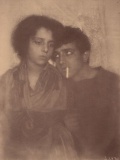
by Wilhelm von Gloeden
- Wilhelm von Gloeden and Pancrazio Buciunì
- Von Gloeden, a famous fin de siècle photographer of Italian youths, hired Buciunì in the early 1880s, when the boy was 13 or 14. Buciunì, called "il Moro," was his lover, assistant and finally his heir. In 1936 Buciunì, as curator of the collection, successfully defended himself against the charge of keeping pornography, accusation made by the Italian fascists, who destroyed most of the remaining 3,000 picture plates.[182]
Pluschow and Galdi, plus picture
- Arthur Rimbaud and Djami Ouddei
- While in Ethiopia in 1883 the adventurer hired a local Harari boy of 14 to 16 years of age who became his constant companion for the remainder of his life in Africa. After his return to France in 1891 in his failed attempt to recover his health, while on his death bed, "it was Djami's name that was always on his lips when he finally sank into unconsciousness." He desired to leave his fortune to Djami, but upon investigations of his sister it was discovered that Djami too had died that same year, thus the money was given to Djami's wife and infant son. Though modern writers have tried to disprove a love relationship between the two, the clear and powerful emotional bond which Rimbaud felt for the young man gives the lie to any attempts to represent their relationship as a mere platonic friendship. [183]
- Lord Henry Somerset and Henry Smith
- Though Somerset had met the commoner when the boy was only seven, their intimate relationship only blossomed about ten years later, in 1878. The lord had to take refuge in Italy shortly thereafter as a result of his irate wife publicizing the affair.[184] He did not return until 1902, after his beloved's death in New Zealand, only to flee back to Florence as soon as he could, to escape his wife's incessant hounding.[185] Driven to poetry, he produced a collection titled Songs of Adieu which was reviewed by Oscar Wilde:
Lord Henry Somerset's verse is not so good as his music. Most of the Songs of Adieu are marred by their excessive sentimentality of feeling and by the commonplace character of their weak and lax form. There is nothing that is new and little that is true in verse of this kind [...] It can be produced in any quantity. Lord Henry Somerset has too much heart and too little art to make a good poet, and such art as he does possess is devoid of almost every intellectual quality and entirely lacking in any intellectual strength. He has nothing to say and says it.[186]
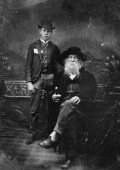
- Walt Whitman and Bill Duckett
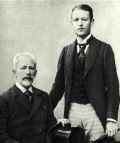
- Peter Ilich Tchaikovsky and Vladimir Lvovich Davïdov
- The composer was in love with his nephew (b. 1871), nicknamed Bob, from the time the boy was 13 until the elder's death at 53. Symphony no. 6 (Pathétique) was inspired by that love, and dedicated to Davydov. His love for the boy was unshaken by Bob's maturation, and was reciprocated by the youth. Bob shot himself in 1906 at the age of 34. [190][191]
- Peter Ilich Tchaikovsky and Alexei Ivanovich Sofronov
- His valet and lover, who came into his service when he was in his mid-teens, brought in by his older brother. At T's death he inherited 1/7th of all that T. owned and used the money to buy the villa that T rented in Klin, which he turned into a museum in the honor of his dead master and lover.
Image:Robert Ross at 24.jpg
- Oscar Wilde and Robbie Ross
- Ross, at 17 a journalist and future literary executor to Wilde, seduced his 32-year-old mentor in 1886.[192]
- Mwanga II of Buganda and Muwafu
- The Kabaka systematically repressed Christian converts, and was driven to a spate of executions by discovering that his pages, with whom he was accustomed to have sexual relations, were being indoctrinated to resist his advances. The matter was discovered in late May, 1886, when he called for the 14-year-old Muwafu, one of his regular favorites, only to be told the boy was unavailable as he was receiving religious instruction. The next morning all the Cristian pages were sentenced to be burned to death, and the execution took place a week later. In total, 22 young men lost their lives in this incident.[193][194]
- Charles Kains Jackson and Cecil Castle
- Jackson, active in the turn-of-the-century Uranian circles had the 14-year-old Castle as his boyfriend in 1888. The boy also posed nude for Henry Scott Tuke's The Bathers and for Frederick Rolfe's camera. (Rictor Norton on British pederastic art) They remained lifelong friends. Upon Castle's death in 1922 Jackson published a collection of poems, Finibus Cantat Amor, and two years later another, titled Lysis, in memory of his friend.[195]
- Lord Arthur Somerset and Algernon Alleys
- Somerset, an intimate of the Prince of Wales, fell in love with a London telegraph boy who moonlighted at Charles Hammond's male brothel at 19 Cleveland Street. He wrote the lad a number of incriminating letters, which, once revealed in the investigation of the Cleveland Street scandal, prompted his self-imposed exile on the continent in 1889.[196]
- John Ellingham Brooks and Somerset Maugham
- Brooks, an impoverished British pianist about 26 at the time, had an affair in 1890 with the 16-year-old Maugham in Heidelberg, where the latter was at university. It was the boy's first sexual experience.[197]
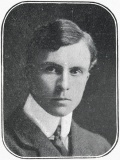
- Eric Stenbock and Norman O'Neill
- Count Stenbock met the 16-year-old O'Neill on the upper deck of a London omnibus in 1891, where he immediately fell in love with the youth. Two years later he assisted O'Neill with his studies at conservatory in Germany, and left him £1500 in his will.[198]
- Charles D. Williamson and Salvatore
- Williamson, a former pupil of Johnson Cory and former beloved of Reginald Brett, took Catholic orders and moved to Italy, where in 1892 he developed a relationship with a 15-year-old youth whom he also appointed as houseboy. They were together for four years, until the boy's death.[199]
- André Gide and Ali
- The first homoerotic encounter of the young writer, in North Africa, with a young Arab.[200]
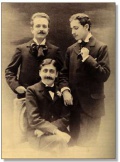
- Marcel Proust et Lucien Daudet
- Twenty three years old and already in love with another teenager, the eighteen year old Reynaldo Hahn, Proust met in 1894 the sixteen year old son of the author Alphonse Daudet. He would pick up Lucien, , himself a friend of Hahn, from his art school, the prestigious Académie Julian where he was studying painting. They spent their time together flitting about French high society, breaking up with convulsive laughter over the quaint habits and stiff seriousness of the times, to the distress of their elders.
- Their fling did not go unnoticed in contemporary literary circles. Jean Lorrain , himself a noted homosexual, attacked Proust in "Pall Mall," his gossip column in Le Journal of February 1897. Determined to protect his honor, Proust challenged Lorrain to a duel which ended with an exchange of shots at 25 paces. His affair with Lucien lasted a year and a half,
[201][202][203] Proust and Daudet remained close friends, despite the fact that Lucien eventually left his lover in favor of Jean Cocteau. [204]
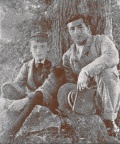
- John Gambril Nicholson and William Alexander (Alec) Melling
- The second of the poet's boyish muses and student at the Rydal Mount School, where Nicholson was teaching, Melling, born in 1878, was the dedicatee of Nicholsen's collection of Uranian poems, A Chaplet of Southernwood, published in 1896. Both left the school in 1894, and Alec did not remain with Nicholson, and later married, in 1925.[205]
- Alfred Douglas and Ali
- Douglas, while the lover of Wilde, was in turn interested in younger boys, such as the Arab youth Ali, whom he selected as traveling companion during his 1895 stay in Algeria. The relationship did not last long, as he found out that the boy was sleeping around with women and promptly whipped him and sent him back to his parents.[206]
- Charles Warren Stoddard and Kenneth O'Connor
- One of several "kids" of Stoddard's, who was fond of boys, O'Connor was a footloose 15-year-old with a little boyfriend of his own when he was taken in by the Notre Dame University professor. O'Connor's overworked mother was glad to hand him over to the older man, "body and bones," and Stoddard created a space in which the two could live in intimity with impunity by being completely open about his love for the boy and presenting himself as the savior of a youth with a troubled home life.[207]
- John Gambril Nicholson and Frank Victor Rushforth
- In his Dead Roses the Uranian poet hides the name of his 13-year-old beloved, his third:
But art is victor still through all the ages
And renders evergreen our sunny hours:
Key to my verse you are; and may its meaning
Every time you turn my volume’s pages
Rush forth to greet you like the scent of flowers![208]
- Norman Douglas and Michele
- Douglas had an affair with the youth, the 15-year-old brother of a mistress of the moment, in Capri in 1897.[209]
- Hector MacDonald and Alaister Robertson
- At the time of the Battle of Paardeberg in 1900, MacDonald's principal friend was Alaister Robertson, a Glenalmond schoolboy from Aberdeen whose photograph he kept on his desk and with whom he corresponded.[210][211]
20th century
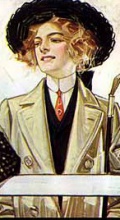
- J. C. Leyendecker and Charles Beach
- The illustrator met his lover in 1901, when the youth was 15. He immortalized the boy - and later the man - by using him as the principal model for The Arrow Collar Man ad campaign. Their relationship lasted 50 years.[212]
- Lytton Strachey and Duncan Grant
- The two, former childhood friends, became lovers in 1902 when Grant was a house guest of the Stracheys in London. He was 17 and Strachey 22. "When he was 17, it was decided that he would join the vast household of his London cousins, the Stracheys. It was not long before Lytton Strachey, five years Grant's senior and openly homosexual, declared himself besotted with his handsome cousin. After several rebuffs -- legend has it Grant told Strachey, Relations we may be: have them, we may not -- Strachey finally had his way, becoming the first of Grant's many male lovers." [213]
- Hector MacDonald and the De Saram boys
- The two De Saram boys, sons of a local Ceylonese burgher with whom MacDonald had become friendly, were reputed to have been the catamites of this distinguished soldier from a humble background, and to have received from him expensive gifts. MacDonald was recalled from Ceylon due to such accusation, and then asked to return there to face a court-martial. On his way there, upon finding out that the international press had got hold of the story, he blew his brains out.[214]
- Friedrich Alfred Krupp and Adolfo Schiano
- "Fritz," as he was known to his friends, had a number of relationships with men and boys during his stays on Capri, but his fondest feelings were reserved for Adolfo Schiano, an 18-year-old barber and amateur musician. Krupp's dalliances with the locals were exposed to the media in retribution for his meddling in local politics, driving the steel magnate and richest man in Europe to suicide in 1902. Before taking his life Krupp made sure to include Schiano in his will.[215]
- Jacques d'Adelswärd-Fersen and Loulou Locré
- Loulou was a pupil at the Lycée Carnot, involved with Fersen in 1903.[216]

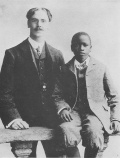
- John Moray Stuart-Young and Ibrahim
- Between 1903 and 1906 the author Stuart-Young was involved with a half-caste youth, known as Ibra or Ibrahim the Unkissed, who worked for him as a servant in Liberia. Their meeting was celebrated in a poem, "But rarer than these treasures superfine, / Thine eyes, indifferent to the girls, in sweet response to mine," and the boy, by then about 14, accompanied Stuart-Young to England during his trip there in 1905.[217]
- Stefan George and Max Kronberger (Maximin)
- A chaste love (one of many for George) which lasted one year, till the boy's death at 16 in 1904. George was then creating a cult that lifted Maximin to a godlike status.[218]
- Jacques d'Adelswärd-Fersen and Nino Cesarini
- St. John Lucas and Rupert Brooke
- Whilst at Rugby in 1904, the 16-year-old RB had a relationship with 25-year-old St. John Lucas, an author and aesthete who gave a great deal of encouragement to RB, and introduced him to the 1890s poets (Wilde, Dowson, etc.).[220]
- Arnold Mohrlen and Carol II of Romania
- Despite the fact that the Swiss tutor was known to be homosexual, he was close to the prince from the time the boy was nine until the age of fifteen, when suddenly the tutor was dismissed and given twenty four hours to leave the country. Queen Marie refers to the tutor and her son as the "two old maids" and later, when the boy reaches the age of eighteen, will blame his carousing on Mohrlen's lasting influence. (The Romanian Story of an Obsession By Bruce Benderson) Upon Mohrlen's being evicted from the country, the collection of his love letters to the prince, from the time this one was ten years old, is found.
- Frederick Rolfe and Ermenegildo Vianello
- Charles Webster Leadbeater and Hubert van Hook
- In 1909 Hubert was a good-looking and very clever 14-year-old who, three years previously, had been chosen by Leadbeater to be trained as the future "World Teacher." He and his mother embarked for India, but during their passage Leadbeater changed his mind and selected for that role a young Indian boy, by the name of Krishna (the future Krishnamurti). Van Hook was left embittered by the experience, and years later denounced Leadbeater to Annie Besant for having "misused" him sexually.[222][223]
- John Moray Stuart-Young and Thomas Olman Todd
- Described as "the love of his life," Tommy Todd, son of the Sunderland occultist by the same name, visited Stuart-Young during his school vacations. Their relationship deepened over the years.[224]
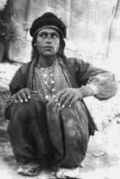
- T. E. Lawrence and Selim Ahmed (Dahoum)
- As he told Robert Graves, the boy was the only person he ever loved. Graves also identifies Ahmed as the mysterious dedicatee of Lawrence's magnum opus, The Seven Pillars of Wisdom which reads "To S.A. I liked a particular Arab very much, and I thought that freedom for the race would be an acceptable present." On the flyleaf of a book of poetry Lawrence wrote, "I wrought for him freedom to lighten his sad eyes, but he had died waiting for me. So I threw my gift away, and now not anywhere will I find rest and peace."[225][226]
- Robert Graves and George H. Johnstone
- In the autumn of 1912, while at Charterhouse School, Graves fell in love with Johnstone, a boy of fourteen ("Dick" in "Goodbye to All That" and "Peter" in his letters). When challenged by the headmaster, Graves defended himself by citing Plato, the Greek poets, Michelangelo and Shakespeare, "who had felt as I did." [Taking it like a man By Adrian Caesar; pp176-7, 180-1] The relationship lasted five years, and broke up around the time when Johnstone was arrested for soliciting a soldier. To his beloved, Graves addressed a poem from the trenches of WWI:
Dear, you have been everything that I most lack
In these soul-deadening trenches—pictures, books,
Music, the quiet of an English wood.
Beautiful comrade-looks,
The narrow, bouldered mountain track,
The broad full-bosomed ocean, green and black,
And Peace, and all that's good.[227]
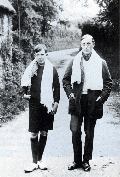
- Philip Streatfeild and Noel Coward
- Streatfeild, a 35-year-old painter and member of the Uranian Society, took the 14-year-old child actor in and introduced him to high society in 1913. Coward is thought to have modeled for his painting of nude boys on the beach. "His "friendship" at age 14 with painter Philip Streatfield (the only relationship about which the program is somewhat coy - homosexuality may have reached a greater level of acceptance today, but man-boy sex is still taboo) led to a connection with aristocrat Mrs. Astley-Cooper, and indeed, residence at the Cooper estate."[228][229]
- Egerton Edwards and Beverley Nichols
- During one of his vacations from public school, Nichols was drawn into a relationship with a neighbor and friend of the family. Edwards provided the schoolboy, who had already experimented sexually with his schoolmates, with an introduction to the world of adult homosexuality, which he chose to inhabit in his later years.[230]
- Became lovers in 1916 when they were 47 and 15, remained friends for life. Allégret was the son of Elie Allégret, best man at Gide's 1895 wedding, and later became a renowned filmmaker.[231]
- Forrest Reid and Kenneth Hamilton
- From 1916 until 1920 the two were linked by an intimate friendship, interrupted by the boy, now 16, leaving to join the Merchant Service and then, at 18, cattle ranching in Australia. Shortly thereafter he rode off alone into the bush, where he is thought to have died.[232]
- John Henry Mackay and Atti
- Mackay fell deeply in love with the Berlin schoolboy in early 1916 during a school holiday.[233]
Image:Mohammed el-Adl.jpg
- E. M. Forster and Mohammed el-Adl
- Forster met the 17-year-old boy in Ramlah around 1917. Their love served as inspiration for much of the writer's later work. (http://www.emforster.info/pages/cavafy.html)
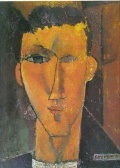
- Jean Cocteau and Raymond Radiguet
- Cocteau met the young poet in 1918 at 29, when the boy was 15 years old. The two collaborated extensively, socialized, and undertook many journeys and vacations together. Cocteau got the youth exempted from military service and exerted his influence to garner the "Nouveau Monde" literary prize for Radiguet's novel, Le Diable au Corps. Many commentators assume that they were lovers.[234][235][236][237][238][239] Their relationship has been placed in the context of "a series of younger lovers and collaborators".[240] An anecdote told by Ernest Hemingway has an enraged Cocteau charging Radiguet (known in the Parisian literary circles as "Monsieur Bébé") with decadence for his tryst with a model: "Bébé est vicieuse. Il aime les femmes." ("Baby is depraved. He likes women." [Note the use of the feminine adjective]). The youth actively sought out relationships with women, explaining that ""Je ne veux pas qu'on m'appelle madame Cocteau."[241] Radiguet also, Hemingway implies, employed his sexuality to advance his career, being a writer "who knew how to make his career not only with his pen but with his pencil," a salacious and phallic allusion.[242][243] In 1919 Radiguet's father discovered a "compromising correspondence" between Cocteau and his son, giving rise to an exchange of letters in November of that year between the two adults in which Cocteau compared the youth to Rimbaud. In mid-March 1921 he hastened from Paris to join Radiguet (among others, including Georges Auric and Monsieur et Madame Hugo Valentin), who had left alone for Carqueiranne. On the 30th of the same month he replied to his mother, who had commented on this voyage: "Have you not yet understood that my life is spent releasing my instincts, watching them, sorting them once they are out, and forging them to my advantage?" After Radiguet's death (of typhoid fever), Cocteau did not attend the funeral, and takes to his bed prostrated with grief. Later he would say "Since the little lucidity I had I got from him, his death left me without instructions, incapable of leading my life coherently, of sustaining and nourishing my work, of providing for it."[244][245] After the death of Radiguet, Cocteau began to use opium, to which he became addicted. This reading of the story is contradicted by Cocteau himself (see below)[[[9]]]
- Others contest this interpretation, claiming that it has not been confirmed in any correspondence or writings by Cocteau or those close to both of them, and that Radiguet had any number of well-documented liaisons with women and generally spent his nights alone at the apparments of Max Jacob and Juan Gris, sleeping on the kitchen table or the floor. Cocteau, speaking about Radiguet in a transcription of a television interview made three months before Cocteau's death claimed that he did not particularly care for Radiguet personally and only respected his talent as a writer. Upon Radiguet's death, which was due to typhoid fever complicated by heavy drinking, Cocteau was, in his own words, "paralyzed with stupor and disgust". He did not attend the funeral—Cocteau did not attend anyone's funeral, as a rule—but instead immediately left Paris with Sergei Diaghilev for Monte Carlo for a performance of Les Fâcheux by Auric and Les Biches by Poulenc. While Cocteau began to smoke opium after Radiguet's death, to which he became addicted, he himself said that this was pure coincidence and had nothing to do with Radiguet's death.[246] Cocteau however was guarded in his discussion of his relationships: "Cocteau never put his name to an openly, unashamedly homosexual text and invariably alluded to his male lovers - the most celebrated being the precocious novelist Raymond Radiguet and the actors Jean Marais and Edouard Dermit - as his 'adopted sons' (in the case of Dermit, even formally adopting him)".[247]
- Others contest this interpretation, claiming that it has not been confirmed in any correspondence or writings by Cocteau or those close to both of them, and that Radiguet had any number of well-documented liaisons with women and generally spent his nights alone at the apparments of Max Jacob and Juan Gris, sleeping on the kitchen table or the floor. Cocteau, speaking about Radiguet in a transcription of a television interview made three months before Cocteau's death claimed that he did not particularly care for Radiguet personally and only respected his talent as a writer. Upon Radiguet's death, which was due to typhoid fever complicated by heavy drinking, Cocteau was, in his own words, "paralyzed with stupor and disgust". He did not attend the funeral—Cocteau did not attend anyone's funeral, as a rule—but instead immediately left Paris with Sergei Diaghilev for Monte Carlo for a performance of Les Fâcheux by Auric and Les Biches by Poulenc . While Cocteau began to smoke opium after Radiguet's death, to which he became addicted, he himself said that this was pure coincidence and had nothing to do with Radiguet's death. Roger Stéphane "Portrait Souvenir de Jean Cocteau" Tallandier 1989 Cocteau however was guarded in his discussion of his relationships: "Cocteau never put his name to an openly, unashamedly homosexual text and invariably alluded to his male lovers - the most celebrated being the precocious novelist Raymond Radiguet and the actors Jean Marais and Edouard Dermit - as his 'adopted sons' (in the case of Dermit, even formally adopting him)". Gilbert Adair, "Comfortable in hell, The Back Half" in The New Statesman, Monday 23rd February 2004
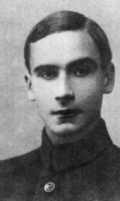
- Karol Szymanowski and Boris Kochno
- Szymanowski, 37, the foremost early-20th–century Polish composer, met Kochno, 15, a poet and dancer, in Elisavetgrad, 1919. The composer wrote four love poems to the boy, and also gave him a Russian translation of "Symposium," the central chapter of his legendary lost novel, Efebos.[248]
- Bishop Palladii and Ivan Volkov
- The bishop, a close friend of Patriarch Tikhon, took the fourteen year old boy as acolyte and lover. Atheist elements in the Bolshevik movement prosecuted the bishop, who served four months of a five year sentence for "corruption of a boy and unnatural vice".
- Gustav Wyneken and Viktor Behrens
- In late 1920, Wyneken had a love affair with his 17-year-old student. A year later he was brought to trial and convicted of acts of frottage.[249]
- Sergei Diaghilev and Boris Kochno
- Kochno was taken on as lover and secretary by Diaghilev at the age of 17 in February 1921. He remained as librettist and close friend till Sergei's death in 1929.[250][251] Later, he was ballet director at Monte Carlo.
- Willem de Mérode and Okke Ubbens
- Okke, whom he met in 1922, was one of de Mérode's chaste pederastic friendships.[252]
- E. M. Forster and Kanaya
- While serving in 1923 as secretary to the Maharajah of Dewas, Forster entered into a regular relationship with Kanaya, a boy barber provided to him by the Maharajah for sexual purposes "if the boy agrees." The relationship lasted six months.[253]
- J. R. Ackerley and Ivan Alderman
- In 1924, having acquired a taste for working class youths, Ackerley spotted the 15-year-old Ivan, who was gay and about to enter art school. Ivan, in his first with an adult, fell head over heels in love. The relationship was to last close to a year, and the breakup was very painful for the young Alderman, who even 60 years later still regarded the affair as the greatest love of his life. For Ackerley it was just one in a long string of relationships.[254][255]
- Maurice Sachs and Tom Pinkerton
- Sullivan, a psychiatrist believed there was a homosexual element to latency age peer relationships and that a failure to go through this stage led to self-loathing, psychosis, and lasting homosexuality. His patients, who were all young male homosexuals as well as schizophrenics, in their positive interactions with the attendants, also young male homosexuals, would heal the wounds from missing male intimacy as pre-people. His own life-long partner came from among his patients, a boy of 15 who moved in with Sullivan in 1927 and remained as his lover for 22 years. Jimmie was known to Sullivan's associates as his adopted son, a fiction whereby he could keep his identity in the closet.[256]
- Matt and Harry Hay
- Aboard a steam ship bound for Los Angeles, the fourteen year old Harry Hay, who had recognized himself as homosexual and later would go on to a life of working for gay rights, had an affair with Matt, a sailor eleven years older than him. At their parting, Matt taught him that wherever he may end up, if a man fixed him with his gaze he could read into that man's eyes a message of attraction, one that he could use as a key to finding others who thought and felt as he did.
- Harry Stack Sullivan and James Inscoe
- Sullivan, a psychiatrist believed there was a homosexual element to latency age peer relationships and that a failure to go through this stage led to self-loathing, psychosis, and lasting homosexuality. His patients, who were all young male homosexuals as well as schizophrenics, in their positive interactions with the attendants, also young male homosexuals, would heal the wounds from missing male intimacy as pre-people. His own life-long partner came from among his patients, a boy of 15 who moved in with Sullivan in 1927 and remained as his lover for 22 years. Jimmie was known to Sullivan's associates as his adopted son, a fiction whereby he could keep his identity in the closet.[257]
- Thomas Mann and Klaus Heuser
- Though the writer's diaries of that period have been lost, later entries reflect on his love affair with Heuser. In 1937 Mann comments about his relationship with the seventeen year old boy, "Last night read for a long time in my diary of 1927 the time of my passion for the boy Klaus H." In 1942 again he comments: "Read for a long time in old diaries from the Klaus Heuser time, when I was a happy lover. [...] Black eyes, the tears shed for me, beloved lips that I kissed—it was there, I had it too, I'll be able to tell myself when I die." The two had one last reunion in 1954. Heuser had remained unmarried.[258]
- Sibghatullah Shah Rashidi and Ibrahim
- Sibghatullah Shah Rashidi, who held the position of Pir Pagaro of the Hurs, a Sufi order. He punished a boy favorite by the name of Ibrahim by having his "eyelashes and eyebrows plucked out, his face blackened with soot, and padlocked him in a box which was opened only when he was fed." The boy escaped only to be hunted down with hounds and locked up in a smaller box. The event was reported to the police by three concubines of the Pir Pagaro. The boy was found in the box, 'looking like a ghost, pale as death, and smelling like a polecat.' Sibghatullah was charged, in 1930, with kidnapping and torture. Defended by Muhammad Ali Jinnah, he was sentenced to eight years in jail. He was paroled in 1936 but restricted to Karachi, from which he escaped in 1941, only to be arrested again for resistance against the British occupation, sabotaging telegraph lines.[259] The Pir was hanged by the British in 1943.
- F. W. Murnau and Garcia Stevenson
- The famous movie director died at the age of 42, together with his young lover, in an auto accident. It seems that shortly beforehand he had hired the handsome fourteen year old Stevenson as a valet. The boy did double duty as chauffeur, and was at the wheel of the Packard convertible when the car plunged off a thirty foot embankment. The position of the bodies and state of undress suggested that a sex act was taking place at the time. Word went around that Murnau was fellating the youth when he lost control of the car. Only eleven people came to the funeral.
- Christopher Isherwood and Heinz Niedermeyer
- Their seven year love affair began in spring of 1932, when the boy was 16. Isherwood later wrote that the relationship was "far more serious than any he had had in his life." [260]
- Aaron Copland and Victor Kraft
- Victor, a talented violinist just out of high school, met Copeland in 1932. The composer thirty two at the time, fell in love with the sixteen year old boy who quickly became, in Copeland's words, his "pupil, companion, secretary and friend!" It was to be the most important romantic relationship of his life. They traveled together to Mexico in August of that year, a trip that lasted four months, divided between the concert halls of Mexico city and the beaches at Acapulco. Upon their return to New York Victor moved in with Copland, who helped him develop a career as photographer. They remained lovers for ten years and friends all their lives. Their separation may have been triggered by Victor's tryst with Leonard Bernstein. All along Victor had an erratic streak that intensified over time, and was often a burden and a disturbance to the composer. In the 1950s Victor married and had a son to whom Copland became godfather. Though Victor predeceased Copland by fourteen years, Copland's largest bequest was to his godson, Jeremy Aaron. [261]
- John Henry Mackay and Otto Hannemann
- Giovanni Comisso and Bruno Pagan
- In 1933 the novelist Comisso (1895–1969) entered into his first significant love relationship with the nephew of a sea captain he had worked for. Initially he took in the boy, who had been released from jail for stealing a bicycle. Eventually their relationship became passionate. It lasted four years, and when the youth left him Comisso was distraught.[262]
- W. H. Auden and Michael Yates
- In 1934 the poet took his former pupil, aged 15 and by Auden's own account one of the five great loves of his life, on travels through Europe, and was inspired by him to write some of his tenderest love poems, such as Lullaby ("Lay your sleeping head, my love, human on my faithless arm . . .")[263][264][265]
- William Alexander Percy and Ford Atkins
- Ford, the son of Louisa Atkins, Percy's cook, was one of Percy's several teenage black boyfriends. Their affair lasted until the day Ford strolled into Percy's bathroom as he was showering, and informed his lover that "You ain't nothing but a little old fat man." Ford was shortly packed off to mechanics' school in Detroit, at Percy's expense.[266][267][268]
- Benjamin Britten and Wulff Scherchen
- The composer met the 13-year-old son of Hermann Scherchen in 1934. Their relationship lasted six years, and inspired at least one major work, Young Apollo. Lie back and think of Britten "Adam Mars-Jones finds that John Bridcut has set himself a daunting task in Britten's Children - to prove whether 'Darling Benjamin' was a mentor or a menace to boys"[269]
- Henry de Montherlant and Edmond N. (Doudou)
- The author picked up the 14-year-old in 1938 and continued the relationship with him in Marseilles where he lived with Edmond's mother and her two sons from 1940 to 1942.[270][271]
Robert Denning in photograph taken by Edgar de Evia in the 1950s.
- Dave Kammerer and Lucien Carr
- Kammerer, a twenty eight year old scion of a prominent St. Louis family, was teaching English in 1939 at Washington University in St. Louis, where he had received his masters. A lover of boys, he had also become a Scoutmaster, and had fallen in love with one of his Scouts, the blond fourteen year old Lucien.
- In order to separate the two, Lucien's parents, also among the aristocracy of St. Louis, sent the youth to the Phillips Academy in Andover, Massachussetts. Kammerer, obsessed, followed the youth to New England, where the two threw parties that scandalized the whole Andover campus, finally leading to Lucien's expulsion from the Academy.
- Carr next was sent to Bowdoin College, at the Maine shore. Kammerer followed, the two again spent time there together until they stole aboard a yacht and scuttled it for kicks. As a result of that prank Carr once again had to decamp, this time going to the University of Chicago, where Kammerer also followed. That lasted until Lucien's attempted suicide. His parents pulled him out of Chicago and sent him to Columbia University. There Carr, a Rimbaudian figure, became the inspiration and glue of the Beat group that included Borroughs, who was another St. Louis luminary and school mate of Kammerer's, and Allen Ginsberg. It was Carr who formulated the method of the creative rebellion of the Beats: 1) Naked self-expression is the seed of creativity. 2) The artist's consciousness is expanded by derangement of the senses. 3) Art eludes conventional morality. This of course echoes the sixteen year old Rimbaud's letter to Izambard, his teacher, revealing his own formula for poetry as a "long, intimidating, immense and rational derangement of all the senses," and his own departure from conventional morality by abandoning himself, while still a boy, to a love affair with an older man.
- The final chapter took place one night in August of 1943 in Riverside Park in New York, when Kammerer, who had followed Carr to New York and had become increasingly unstable, attempted to rape the nineteen year old. The latter took out his Boy Scout knife and stabbed Kammerer, dumping his body in the Hudson River. Carr confessed to the crime, which he claimed had been committed in self defense, and served two years in prison.
- Upon his release he went to work for United Press International, where he rose to the post of head of the news desk. He remained friends with Kerouac and the other Beats, but sought to keep out of the limelight. He also married and fathered three children.
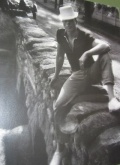
- Edgar de Evia and Robert Denning
- They met in 1942 - de Evia was 32, Denning, 15, their relationship lasted 18 years until Denning met Vincent Fourcade, but they remained close friends for life.[272]
- Giovanni Comisso and Guido Bottegal
- In 1940 Comisso fell in love with the 16-year-old poet, who later was shot by partisans who mistook him for a fascist spy.[273]
- Chisholm and Kenneth Williams
- The future comic actor was billeted during WWII in 1941 at the age of fifteen with a retired veterinarian, a bachelor who is thought to have seduced the youth, who was conscious of his gayness from his teens. [274]
- Wangdu and Tashi Tsering
- In a relationship typical of the ones that Tibetan monks engaged in, Wangdu invited the fourteen-year old Tashi, a member of the Dalai Lama's dance troupe in 1943, to be his drombo ("guest" in Tibetan, in this usage a male love partner). The sexuality was of the Greek type, intercrural. During their years together the only interference came from one or another dop-dop, warrior monks, who took a liking to Tashi and kidnapped him on several occasions hoping to enter into relationship with him. The relationship between Tashi and Wangdu lasted a number of years, and grew into a very strong and lifelong friendship, though their intimacy ended when Wangdu had to move away, an event that was painful for both lovers.[275]
- "Walt" and Rudi van Dantzig
- The 1945 relationship between the 12-year-old van Dantzig and a Canadian soldier was dramatized in van Dantzig's autobiographical book and movie by the same name, For a Lost Soldier.[276]
- Bill Tilden and Bobby
- Tilden, thought at the time of this death to have been the greatest tennis player in history, was apprehended in late 1946 while fondling his 14-year-old friend as the boy was at the wheel of Tilden's car in Beverly Hills. Though Bobby's father, a film studio executive, did not want Tilden incarcerated, and the probation officer concluded that the sexually experienced Bobby "was not injured as much [by Tilden] as are his parents and the general public," he nonetheless served seven months of a one-year sentence.[277]
- Bernard Montgomery, 1st Viscount Montgomery of Alamein and Lucien Trueb
- "Monty" fell passionately in love the twelve-year-old Swiss youth in 1946, and would spend time with him at his chalet in Gstaad. The intimacy only went as far as bathing the boy and towelling him off. Lucien's family saw nothing improper in the love Montgomery showed the boy, and the two corresponded for many years.[278]
- James Baldwin and Lucien Happsberger
- At the time of his first trip to Paris in 1949, Baldwin met and fell in love with Lucien Happsberger. The boy was a Swiss 17-year-old runaway, and the two remained very close, until Happsberger's marriage three years later, an event that left Baldwin devastated.[279]
- Donald Friend and Attilio Guarracino
- In January 1950, Friend met the 18-year-old Guarracino, the son of a fisherman from Ischia. Their love and subsequent friendship was to be one of the most important of his life. Later that year he took the boy with him to Australia. Friend willed half his estate to Guarracino.[280][281] In his diary, Friend described his feelings for Atillio as an "obsessive and passionate love," a "madness" the return of which he dreaded "more than anything [he] could think of."[282] Guarracino was to play a central role in the posthumous publication of Friend's diaries.(pictured)[283]
Christopher Isherwood and Don Bachardy 1953
- Sandro Penna and Raffaele
- The Italian poet took the 14-year-old streetboy from Rome to his home in 1956 and lived with him for several years.[284]
- William S. Burroughs and Kiki
- Jean Genet and Abdallah Bentaga
- The relationship, begun in 1955, between the 45-year-old Genet and the 18-year-old son of an Algerian father and a German mother was one of the most important of Genet's life. He paid for the youth's high-wire act lessons, helped choreograph the act, and came to his aid when he took a fall and seriously injured himself. By the early sixties Genet was becoming involved with a new lover, a matter which, combined with his frustration at his lasting infirmity, drove Bentaga to suicide in February 1964. Genet was distraught, destroyed all the manuscripts in his possession, and attempted suicide himself.[287][288][289]
- René Schérer and Guy Hocquenghem
Ninetto Davoli as Othello, 1968
- James Merill and Strato
- The American poet and the Greek boy meet in 1961, and by 1975 Strato is growing up and is old enough to look for a wife.
Image:Ninetto Davoli Otello 1968.jpg
- Pier Paolo Pasolini and Ninetto Davoli
- The Italian poet, novelist and film director Pasolini started a relationship with the 15-year-old Davoli in 1963 and let him play many comic roles in his movies.[292]
- Peyrefitte met the 12-year-old boy during the filming of his novel Les Amitiés particulières in spring 1964. Their love is described in Notre amour and L'Enfant de cœur. Malagnac lived with him from the age of 16, and eventually married Amanda Lear.[293]
- Harvey Milk and Jack McKinley
- Milk met McKinley in New York in 1963, when Milk was 33 and McKinley was 16. Their relationship lasted five years.
- Alexander Ziegler and Stephan (Mutscha)
- In 1966 the 22-year-old Swiss actor and writer was sentenced to a two and a half year jail term for a love affair with the 16-year-old Stephan, documented in the autobiographical novel Die Konsequenz and later turned into a movie with the same name by director Wolfgang Petersen. Die Konsequenz , shown on German television, had a pivotal role in that country in starting a dialog on the topic of homosexuality, a role analogous to that played by Peyrefitte's films in France.[294]
- Anthony Mercieca and Mark Foley
- Father Mercieca and the future US Congressman engaged in a two year relationship starting in 1967, when F. was 13 years old. In The Herald Tribune "Father Anthony Mercieca said Thursday he never had sexual intercourse with former U.S. Rep. M. F., but throughout the day offered more details to national media outlets about his intimate relationship with the then-Lake Worth altar boy. Mercieca told the Washington Post he and F. once engaged in "light touching" and told CNN he fondled F. when he was a teen, though he didn't consider the contact abuse because F. "seemed to like it."[295]
- Scott Symons and John
- Symons left his wife and child and eloped with the 17-year-old John in 1967, travelling through Mexico, chased by the Royal Canadian Mounted Police (RCMP), the Interpol and the Mexican police. He returned to Canada to claim a literary prize, and met with Pierre Trudeau, a meeting which, according to Symons, resulted in the decriminalization of homosexuality in Canada in 1968.[296]
- Liberace and Scott Thorson
- In 1977 the entertainer hooked up with the 18 year old youth. They were together for five years.
- Liberace and Cary James
- They hooked up in 1982 when L was 62 and Cary was an 18 year old chorus boy. They were together for five years, until L's death from AIDS. James was infected by him and died in 1997, ten years after his lover.
- Cary had replaced Scott Thorson.
BIBLIOGRAPHY
- Louis Crompton. Homosexuality and Civilization, Cambridge, Mass. and London, 2003. ISBN 0-674-01197-X
- Michel Larivière. Homosexuels et bisexuels célèbres, Delétraz Editions, 1997. ISBN 2-911110-19-6
- Stephen O. Murray and Will Roscoe, et al. Islamic Homosexualities: Culture, History, and Literature, New York: New York University Press, 1997. ISBN 0-8147-7468-7
- J. Wright & Everett Rowson. Homoeroticism in Classical Arabic Literature. 1998.
- 'Homosexuality' & other articles in the Encyclopædia Iranica
- Chinese couples documented in Hinsch, 1990, p. 37, 69.
- Serge Bramly. Leonardo : The Artist and the Man, Penguin, 1994. ISBN 0-14-023175-7
- Michael Matthew Kaylor, Secreted Desires: The Major Uranians: Hopkins, Pater and Wilde (2006)Michael Matthew Kaylor, Secreted Desires: The Major Uranians: Hopkins, Pater and Wilde (2006), a 500-page scholarly volume that considers the major Victorian pederastic writers and their relationships (the author has made this volume available in a free, open-access, PDF version).
References
- ↑ Richard A. Posner, Sex and Reason; p148 N3
- ↑ Hubbard, Thomas K. "Introduction" to Homosexuality in Greece and Rome: A Sourcebook of Basic Documents. Berkeley: University of California Press, 2003. pg. 9.
- ↑ El-Rouayheb, Khaled (2005) The Love of Boys in Arabic Poetry of the Early Ottoman Period, 1500–1800, Middle Eastern Literatures 8,1:3-22.
- ↑ Kaylor, Michael M. Secreted Desires: The Major Uranians: Hopkins, Pater and Wilde. Brno, CZ: Masaryk University Press, 2006.
- ↑ The red thread: Buddhist approaches to sexuality By Bernard Faure; p259
- ↑ Timon Screech; Sex and the Floating World; p157
- ↑ The Teachings of Confucius, Chapter 10:1
- ↑ Male Colors By Gary P. Leupp; p13
- ↑ (Leupp, 13)
- ↑ Male Colors By Gary P. Leupp; p14
- ↑ Passions of the Cut Sleeve By Bret Hinsch; pp71-2
- ↑ Passions of the cut sleeve: the male homosexual tradition in China By Bret Hinsch; p69-70
- ↑ When Baghdad Ruled the Muslim World By Hugh Kennedy, p.122
- ↑ When Baghdad Ruled the Muslim World By Hugh Kennedy, p121
- ↑ Philip F. Kennedy, Abu Nuwas, a Genius of Poetry. pp.3-4;
- ↑ One World, Oxford, 2006 Abu Nuwas went on to become a prolific writer of mudhakkarat (boy love) poetry. ʻAbbasid belles-lettres By Julia Ashtiany, J. D. Latham, p.296
- ↑ Passions of the cut sleeve: the male homosexual tradition in China By Bret Hinsch; p.78
- ↑ Before homosexuality in the Arab-Islamic world, 1500-1800 By Khaled El-Rouayheb; p86
- ↑ Slave soldiers and Islam By Daniel Pipes; p.99 N103
- ↑ Louis Crompton, Homosexuality and Civilization, p.202
- ↑ Christianity, social tolerance, and homosexuality By John Boswell, American Council of Learned Societies; p196
- ↑ Crompton, p.183
- ↑ Encyclopedia of Gay, Lesbian, Bisexual, Transgender & Queer Culture, Europe:Medieval, Eugene Rice
- ↑ Cordove Quero, "A Queer Reading of Aelred of Rievaulx" in The sexual theologian By Marcella Althaus-Reid, Lisa Isherwood, p.30-32
- ↑ Thomas Becket By Frank Barlow; pp33-34
- ↑ Encyclopedia of Arabic Literature By Julie Scott Meisami, Paul Starkey; p367
- ↑ The African dispersal in the Deccan: from medieval to modern times By Shanti Sadiq Ali; p35
- ↑ Landmarks of the Deccan: a comprehensive guide to the archaeological remains ... By Syed Ali Asgar Bilgrami; p189
- ↑ E. J. Brill's First Encyclopaedia of Islam, 1913-1936 By Martijn Theodoor Houtsma; p1167
- ↑ Same-sex love in India: readings from literature and history By Ruth Vanita, Saleem Kidwai; p132
- ↑ Muslim identity, print culture, and the Dravidian factor in Tamil Nadu By J. B. Prashant More; p11 History of Delhi Sultanate By M H Syed; p95
- ↑ Islamicate sexualities By Kathryn Babayan, Afsaneh Najmabadi; pp206-7
- ↑ " Giorgio Vasari, Lives of the Artists, "Filippo di ser Brunelesco"
- ↑ " Art theory By Robert Williams; p68 The Feud That Sparked the Renaissance By Paul R. Walker; pp33-36
- ↑ Radu R Florescu, Raymond McNally, Dracula, Prince of Many Faces: His Life and His Times pp.47-48
- ↑ A General history of the several nations of the world: from the flood, to ... By Thomas Salmon; p.153; ed. 1751
- ↑ Beurdeley, Cécile. L'amour bleu, Fribourg 1977
- ↑ Michael White Leonardo p.137
- ↑ Richard Dellamora; Masculine desire. p.143.
- ↑ Asian homosexuality By Wayne R. Dynes, Stephen Donaldson; p33
- ↑ "Giovanni dall'Orto: "[4a La vicenda (perfino un poco bocaccesca) è narrata in dettaglio in due biografie anonime del XVI secolo intitolate Vita di Benedetto Varchi, che si leggono in: Benedetto Varchi, Storie fiorentine, Le Monnier, Firenze 1857, vol. I. Per l'episodio in questione vedi le pp. XVII-XVIII e 355-357. Cfr. anche Manacorda, Op. cit., p. 11."]
- ↑ Queering the Renaissance By Jonathan Goldberg pp164-167 The Politics of Performance in Early Renaissance Drama By Greg Walker, p.164
- ↑ The life of Michelangelo Buonarroti By John Addington Symonds; p.154
- ↑ Letters of Michelangelo By Michelangelo, Michelangelo Buonarroti, E. H. Ramsden; p.257
- ↑ John Addington Symonds p.154
- ↑ "...sono ben noti alcuni suoi affetti omosessuali per Cecchino dei Bracci" Storia d'Italia? - Page 1310; by Ruggiero Romano, Corrado Vivanti, Giulio Einaudi editore; 1972
- ↑ "The beginning of the intimate and rather moving friendship which grew up between them dates from about 1541." Letters of Michelangelo By Michelangelo, Michelangelo Buonarroti, E. H. Ramsden; pp244-6
- ↑ Not the present one in Firenze, but one located on today's Largo Argentina. See "Ut Pictura Convivia: Heavenly Banquets and Infernal Feasts in Renaissance Italy" by Guendalina Ajello Mahler in Viator Volume 38, Number 2 / 2007; N.Ed.
- ↑ Michelangelo By George Anthony Bull; p.313-4
- ↑ Opere politiche e letterarie By Donato Giannotti, Filippo Luigi Polidori; p.388
- ↑ The life of Michelangelo Buonarroti By John Addington Symonds; pp152-3
- ↑ Who's who in gay and lesbian history By Robert Aldrich, Garry Wotherspoon; pp191-2
- ↑ Symonds, 153
- ↑ Ramsden, 256
- ↑ Michelangelo By George Anthony Bull; p.314-316
- ↑ [["Qui la carne, ora ridotta a polvere, e le mie ossa/ prive dei begli occhi e della mia bellezza/ rendono testimonianza a colui a cui portai grazia nel letto,/ che abbracciavo, e nel quale la mia anima continua a vivere." "MICHELANGELO BUONARROTI" by Giovanni Dall'Orto Babilonia n. 85, January 1991, pp. 14-16]]
- ↑ The Pursuit of sodomy By Kent Gerard, Gert Hekma; pp.51-2
- ↑ Who's who in gay and lesbian history By Robert Aldrich, Garry Wotherspoon; p278
- ↑ Richard G. Mann, Papacy in glbtq; p.6
- ↑ Burkle-Young, The life of Cardinal Innocenzo del Monte, pp. 180-181 [after [[[1]]]
- ↑ Francis Burkle-Young and Michael Leopoldo Doerrer, "The life of Cardinal Innocenzo del Monte: A Study in Scarlet", NY, 1997; P. Messina, 'Del Monte, Innocenzo', Dizionario biografico degli italiani, Vol 38, Rome, 1990
- ↑ La gaya scienza, Théodore de Bèze
- ↑ Queers in History, compiled by Paul Halsall
- ↑ Giovanni Dall'Orto, "'Socratic Love' as a Disguise for Same-Sex Love in the Italian Renaissance," in The Pursuit of Sodomy: Male Homosexuality in Renaissance and Enlightenment Europe, pp.55-57
- ↑ Maurice Lever, Les bûchers de Sodome, p.89
- ↑ Antiquitez de Rome By Joachim Du Bellay, Richard Helgerson; p154-5
- ↑ Giovanni Dall'Orto, Edito originariamente in Babilonia n. 85, gennaio 1991[[[2]]]
- ↑ Benvenuto Cellini: Sexuality, Masculinity, and Artistic Identity in Renaissance Italy By Margaret A. Gallucci; p.18
- ↑ Translation out of the Italian by Wikipedia editor Haiduc
- ↑ Who's who in gay and lesbian history: from antiquity to World War II By Robert Aldrich, Garry Wotherspoon; p112
- ↑ Pelo vaso traseiro: sodomy and sodomites in Luso-Brazilian history? - pp.195-209
- ↑ Anna Suvorova, Muslim Saints of South Asia; p.194-196
- ↑ Hidden from history: reclaiming the gay and lesbian past By Martin B. Duberman, Martha Vicinus, George Chauncey; p93,98
- ↑ A tragic grace: the Catholic Church and child sexual abuse By Stephen J. Rossetti, Interfaith Sexual Trauma Institute (Collegeville, Minn.); p104
- ↑ Who's who in gay and lesbian history: from antiquity to World War II By Robert Aldrich, Garry Wotherspoon; p359
- ↑ The Italian world of English Renaissance drama: cultural exchange and ... By Michele Marrapodi, A. J. Hoenselaars; p112
- ↑ Crompton, op.cit., p.390
- ↑ Maurice Lever, Les bûchers de Sodome, p.90
- ↑ Who's who in gay and lesbian history By Robert Aldrich, Garry Wotherspoon, p186
- ↑ The Pursuit of sodomy By Kent Gerard, Gert Hekma; p81
- ↑ M: The Man Who Became Caravaggio By Peter Robb p.10
- ↑ Top Ten- Lives of the Greatest Monarchs of History By Mohsin Ashraf; p.104
- ↑ An Outline History of French Literature By H. Stanley Schwarz; p.43
- ↑ "Balzac aurait eu quatorze ou quinze ans. S'il part sans l'aveu de son père, il s'agit bien d'une fugue." Jean Jehasse, Guez de Balzac et le génie romain: 1597-1654? - Page 82 N34
- ↑ Powerful connections By Peter William Shoemaker; p.59
- ↑ Études sur l'Espagne et sur les influences de la littérature espagnole en ... By Philarète Chasles; p.396
- ↑ Who's who in gay and lesbian history By Robert Aldrich, Garry Wotherspoon; p.544
- ↑ "Ils se brouillent au retour, et leurs mutuelles accusations nous instruisent de leurs fredaines." Les victimes de Boileau, Philarète Chasles, Revue des Deux Mondes T.18, 1839
- ↑ The gendering of men, 1600-1750 By Thomas Alan King; p.35
- ↑ The gendering of men, 1600-1750 By Thomas Alan King; p.35
- ↑ Lords of the Horizons By Jason Goodwin; p171
- ↑ Turkish Art of Love By Pinhas Ben Nahum; p92
- ↑ "Richelieu introduced to Louis around 1637 the handsome young Henri d'Effiat, Marquis de Cinq-Mars (b. 1620)" Jonathan to Gide: the homosexual in history? By Noel I. Garde; p.347
- ↑ The Bourbon kings of France? - Page 64 by Desmond Seward
- ↑ Elite theatre in Ming China, 1368-1644 By Grant Guangren Shen; p40-1
- ↑ Homoerotic sensibilities in late imperial China By Cuncun Wu; p42
- ↑ Kent Gerard, Gert Hekma, The Pursuit of sodomy, Routledge, 1989, p. 119; cfr. Peter Rietbergen, Power and religion in Baroque Rome: Barberini cultural policies, BRILL, 2006, p. 163
- ↑ Mistress of the Vatican
- ↑ John Bargrave, Pope Alexander the Seventh and the College of cardinals, ed. James Craigie Robertson, 1867, p. 28 ff. Cfr. Antonio Barberini (entry by S. Miranda)
- ↑ Robert Aldrich, Garry Wotherspoon, Who's Who in Gay and Lesbian History
- ↑ 101.0 101.1 Maurice Lever, Les bûchers de Sodome p.127
- ↑ DANNY HAKIM Published: December 26, 2009; "His Specialty? Making Old New York Talk in Dutch" in The New York Times[[[3]]]
- ↑ "van den Bogaert, the former commissary of Fort Orange, fled justice after being accused of sodomizing Tobias, a Negro boy slave (Neger jongen slave)" Sex without consent: rape and sexual coercion in America? - Page 74 Merril D. Smith
- ↑ Maurice Lever, Les bûchers de Sodome p.212-3
- ↑ "When he was in his late forties, Moliere fell in love with fifteen-year-old Michel Baron," Martin Greif, The gay book of days: an evocatively illustrated who's who...? - P. 24
- ↑ "It was written in the heavens that [Moliere] would be cuckolded in every way." Molière By Virginia Scott; pp. 212-215
- ↑ Albert Romer Frey, Sobriquets and Nicknames p.178
- ↑ Harbottle, Thomas Benfield, Dictionary of Historical Allusions p.217
- ↑ Maurice Lever, Les bûchers de Sodome p.160-1
- ↑ The Origins and Role of Same-Sex Relations in Human Societies By James Neill; p.406
- ↑ Jean-Baptiste Lully By Ralph Henry Forster Scott; p.102
- ↑ Gay Histories and Cultures By George E. Haggerty; p.554
- ↑ Lariviere, 228-229
- ↑ Fifty years of my life By George Thomas Keppel Albemarle (Earl of; p303
- ↑ Mrs. Keppel and Her Daughter By Diana Souham; p19
- ↑ Monarch: The Life and Reign of Elizabeth II, By Robert Lacey; p52
- ↑ Royal mistresses By Charles Carlton; p93
- ↑ The Anglo-Dutch favourite By David Onnekink: p229
- ↑ Perilous enlightenment By George Sebastian Rousseau; p24
- ↑ Memoirs of the court of England from ... 1688 to the death of George the second By John Heneage Jesse; p235
- ↑ Jesse, 235
- ↑ Handel as Orpheus By Ellen T. Harris; p39
- ↑ Edward Carpenter, Ioläus: An Anthology of Friendship; 2009; p117; BiblioBazaar, LLC, 2009 ISBN 0559124376, 9780559124372
- ↑ Michel Lariviere, "Homosexuels et bisexuels celebres" p.329
- ↑ "Hippolyte de Seytres ensuite, qui avait seize ans au début de leur relation, en 1740" L'amour philosophique: l'homosexualité masculine au siècle des Lumières? - Page 188 by Didier Godard; 2005
- ↑ Oeuvres de Vauvenargues, Volume 1 By Vauvenargues; p141
- ↑ Turkish Art of Love By Pinhas Ben Nahum; p94
- ↑ The dramatic cobbler: the life and works of Isaac Bickerstaff By Peter A. Tasch; p236
- ↑ John Wilkes: the lives of a libertine By John Sainsbury; p96
- ↑ History of homosexuality in Europe and America By Wayne R. Dynes, Stephen Donaldson; p317
- ↑ Guy Chapman, Beckford (1940), pp81-2
- ↑ Jay Losey, William Dean Brewer, Mapping Male Sexuality p.148
- ↑ Opus ultimum By Daniel N. Leeson; pp42-44
- ↑ Dom Pedro By Neill Macaulay; p.307 N19
- ↑ William Beckford By James Lees-Milne; p33
- ↑ Stephen O. Murray and Will Roscoe, Islamic Homosexualities, p.189-191
- ↑ Bandits at sea By C. R. Pennell; pp.246-247
- ↑ Eisler, Benita. Byron: Child of Passion, Fool of Fame, Vintage Books USA, May 2000
- ↑ Byron in his letter to John Cam Hobhouse - The Convent, Athens, August 23rd, 1810
- ↑ Fiona MacCarthy, Byron: Life and Legend p.128
- ↑ Hubert Kennedy, Book review in Journal of Homosexuality 35(2) (1998): 85–101. Eros: Die Männerliebe der Griechen, ihre Beziehungen zur Geschichte, Erziehung, Literatur und Gesetzgebung aller Zeiten by Heinrich Hössli
- ↑ capitalpunishment.org Newgate executions 1800 - 1836
- ↑ Queer theory/sociology By Steven Seidman, p46
- ↑ Masculine desire By Richard Dellamora; p.226N22
- ↑ "FitzGerald and the Rubaiyat, in and out of time" in Victorian Poetry, Spring, 2008 by Erik Gray
- ↑ The life of Edward Fitzgerald By Thomas Wright; p.157
- ↑ Creating literature out of life By Doris Alexander; pp.52-4
- ↑ [On Burton’s mention of the pederastic morals of Ranjit Singh] Colonialism and homosexuality By Robert F. Aldrich; p31
- ↑ ”Victorian England viewed pederasty, common in Asia, with disgust. […] Hira Singh, Dhian Singh’s son, also became the object of the Maharaja’s infatuation, thus affording further protection to the grasping ambition of the Jammu family.” Hari Singh Nalwa - Champion of the Khalsaji By Vanit Nalwa; p201
- ↑ Strangers Within the Gates By Gabrielle Festing; p381
- ↑ '[Dhian Singh]’s son, Hira Singh, lauded frequently for his beauty and described as “the handsomest man in the East,” was a particular favorite of the [Lahore] maharaja. Ranjit Singh, it is reported, could not bear to be parted from him for long, and Hira Singh alone was alloed to sit before him on a chair, while other courtiers stood, or took less exalted places on the floor.” Hindu rulers, Muslim subjects By Mridu Rai; p24
- ↑ ”The most able and powerful men about the court were undoubtedly the Jammu brothers, Gulab Singh, Dhyan Singh and Suchet Singh, to whom may be added Hira Singh, son of Dhyan Singh.” ”Hira Singh in after times gave proof of both wisdom and courage.” The Career of Major George Broadfoot By William Broadfoot, George Broadfoot, Edward Law Ellenborough, Henry Hardinge Hardinge; p220
- ↑ The Sikhs of the Punjab By J. S. Grewal; p122
- ↑ Empire and Sexuality: The British Experience, Ronald Hyam; p47
- ↑ Empire and Sexuality: The British Experience, Ronald Hyam; pp.44-45
- ↑ Bradley Wintertonin, "What Palmerston Knew" in London Review of Books, Letters, Vol. 25 No. 10 Cover date: 22 May 2003
- ↑ Literary Encyclopedia: John Addington Symonds
- ↑ Charley Shively, Drum Beat: Walt Whitman's Civil War Boy Lovers, pp.47-48
- ↑ The Oblate assault on Canada's northwest By Robert Choquette; pp.61-62
- ↑ Oliver S. Buckton, Secret Selves: Confession and Same-Sex Desire in Victorian Autobiography p.95
- ↑ Brown 60-1
- ↑ Orlova, 36
- ↑ Beurdeley, Cécile. L'amour bleu, Fribourg 1977
- ↑ Love's Litany By Kevin Kopelson, p.62
- ↑ The forger's tale By Stephanie Newell; p78
- ↑ Morris B.Kaplan, "Sodom on the Thames; p.150
- ↑ H. Montgomery Hyde, The Love That Dared not Speak its Name; p.118
- ↑ Linda Dowling, Hellenism and Homosexuality in Victorian Oxford p.115
- ↑ Bart Schultz Henry Sidgwick: Eye of the Universe - An Intellectual Biography p.411
- ↑ Morris B. Kaplan, Sodom on the Thames: Sex, Love, and Scandal in Wilde Times p.107
- ↑ Colonialism and homosexuality By Robert F. Aldrich; p35
- ↑ "Sanitizing the Classics" by Donald Rayfield, in Comparative Criticism: Volume 16, Revolutions and Censorship By Elinor S. Shaffer; p27
- ↑ Timothy Unwin, Jules Verne: Journeys in Writing, p.110
- ↑ Jean Paulhan, introduction to Marcel Moré The Very Curious Jules Verne «Marcel Moré soutient dans ce livre deux thèses parallèles. L'une est qu'il nous faut dans la vie substituer peu à peu à notre père naturel (dont il n'y a rien de bon à attendre) un homme plus âgé et meilleur que nous et qui nous instruit du sens de la vie, qu'il appelle un père sublime. Plus tard nous aurons également à substituer à notre femme un ami digne d'estime et d'admiration... La seconde thèse tend à montrer que l'œuvre entier de Jules Verne a pour raison et pour secret la pédérastie.»
- ↑ Marc Soriano. Jules Verne (Le cas Verne). Paris: Julliard, 1978
- ↑ Marc Angenot, "Books in Review — New Books on Jules Verne" in Science-Fiction Studies, VI #18 (July 1979): 224–227
- ↑ Raymond Queneau, introduction to Marcel Moré The Very Curious Jules Verne «L'auteur s'appuie sur le peu que l'on sait de la vie de Jules Verne et sur une exégèse fort intéressante de ses écrits. Il y a relevé un certain nombre de citations qui sont effectivement "très curieuses". D'autre part, certains détails de la vie de Jules Verne (si peu connue) ne manquent pas d'inattendu : par exemple, son amitié (pour ne pas dire plus) pour le jeune Aristide Briand, l'attentat dont il fut victime de la part d'un de ses neveux, etc. Voilà un livre qui sort des sentiers battus de l'histoire littéraire.»
- ↑ Frederick W. Haberman, Irwin Abrams. Peace p.4; 1997. ISBN 9810234155
- ↑ Michel Larivière, Homosexuels et bisexuels célèbres.pp.331–332
- ↑ Larivière, op.cit.
- ↑ William Butcher, Jules Verne: The Definitive Biography p.xxv. Thunder's Mouth Press, 2006
- ↑ Gay histories and cultures By George E. Haggerty p.901
- ↑ Robert Aldrich, Colonialism and homosexuality p.94
- ↑ Kaylor, 2006 p.299-300
- ↑ Timothy d'Arch Smith, Love in Earnest pp.24-27
- ↑ Oscar Wilde, "THE POETS' CORNER--IX" in Pall Mall Gazette, March 30, 1889.
- ↑ G. Eiselein in American Quarterly, 1998; "Whitman enjoyed romantic relationships with a number of young working-class men such as Fred Vaughan, Peter Doyle, Harry Stafford, and Bill Duckett."
- ↑ Breaking bounds By Betsy Erkkila, Jay Grossman; pp211-212
- ↑ Eakins revealed By Henry Adams, Thomas Eakins; p.289
- ↑ Timothy L. Jackson; Tchaikovsky, Symphony no. 6 (Pathétique) pp.38-9
- ↑ (R. Norton's article on their relationship and the composer's forced suicide)
- ↑ "...it was the experience with Ross that decided him to accept himself for the future completely as a pederast..." Ireland in Proximity By Scott Brewster, David Alderson, p.75 (quoting Michael MacLiammoir)
- ↑ Saints of Africa By Vincent J. O'Malley; p74
- ↑ The Uganda Martyrs, Barry M Coldrey, 1939
- ↑ Timothy d'Arch Smith, Love in Earnest; p. 152
- ↑ H. Montgomery Hyde, The Love That Dared not Speak its Name; pp.123-5
- ↑ Morgan, Ted Somerset Maugham, Jonathan Cape, 1980. ISBN 0-224-01813-2; p.24
- ↑ Timothy D'Arch Smith, Love in Earnest pp.35
- ↑ Morris B.Kaplan, op.cit. p.153-162
- ↑ Andre Gide, Si le grain ne meurt
- ↑ Dictionnaire gay? by Lionel Povert; 1994. Page 381 "après avoir été l'amant de Reynaldo Hahn, est celui du joli Lucien Daudet...
- ↑ Proust in love By William C. Carter; pp32, 47-56, 58, 62
- ↑ Proust in love By William C. Carter; pp32, 47-56, 58, 62
- ↑ "A Reynaldo Hahn succède Lucien Daudet, fils du romancier et cadet du déjà célèbre Léon. ... De son côté Daudet le lâche sans scrupules pour Cocteau." Proust? by Anne Henry; 1986; - Page 43
- ↑ Timothy d'Arch Smith, Love in Earnest. pp.55, 125, 129, 157N42, ; Routledge & Keegan Paul; London, 1970
- ↑ André Gide: a life in the present By Alan Sheridan; p119
- ↑ Genteel Pagan: The Double Life of Charles Warren Stoddard By Roger Austen, John W. Crowley; pp132-8
- ↑ Timothyd’Arch Smith, Love in Earnest: Some Notes on the Lives and Writings of English‘Uranian’ Poets from 1889 to 1930 (London: Routledge and Kegan Paul, 1970), p.128
- ↑ Who's who in gay and lesbian history By Robert Aldrich, Garry Wotherspoon; p.160
- ↑ Empire: The British Imperial Experience from 1765 to the Present; Dennis Judd, pp171-172
- ↑ Empire and Sexuality: The British Experience, Ronald Hyam; pp.34-35
- ↑ Empire and Sexuality: The British Experience, Ronald Hyam; pp.34-35
- ↑ New York Times June 6, 1999: "Bloomsbury's Secret" By ANDREA BARNET; book review of Duncan Grant: A Biography by Frances Spalding.
- ↑ Colonialism and homosexuality By Robert F. Aldrich; p188
- ↑ Robert Aldrich, The Seduction of the Mediterranean, page 127
- ↑ Will H.L. Ogrinc (2006), "FRÈRE JACQUES: A SHRINE TO LOVE AND SORROW Jacques d’Adelswärd-Fersen (1880-1923)" Revised and augmented version of the first edition, published in Paidika. The Journal of Paedophilia 3:2 (1994), pp. 30-58. Will H.L. A German version was published in Hamburg (MännerschwarmSkript Verlag) in 2005
- ↑ Timothy d'Arch Smith, Love in Earnest, p.207-208
- ↑ David, Claude. Stefan George. Son Oeuvre Poétique, Paris 1952
- ↑ Infinite Variety By Scot D. Ryersson, Michael Orlando Yaccarino, Quentin Crisp; p.105
- ↑ History Of Homosexuality In Europe, 1919-1939 By Florence Tamagne; p.14N10
- ↑ Giovanni Dall'Orto, Cultura Gay
- ↑ J. Krishnamurti: the open door By Mary Lutyens; p.6
- ↑ The life and death of Krishnamurti By Mary Lutyens; p8
- ↑ Stephanie Newell, The Forger's Tale: The Search for Odeziaku p.86
- ↑ Robert Aldrich, Gay Life and Culture p.15
- ↑ Colonialism and homosexuality By Robert F. Aldrich; pp76-77
- ↑ The early poetry of Robert Graves: the goddess beckons By Frank L. Kersnowski; p12
- ↑ Arthur Lazere, review of The Noel Coward Story (on PBS in January, 1999), The Culture Vulture website review on PBS show in January, 1999.
- ↑ Philip Hoare, Noel Coward: A Biography p.32-33
- ↑ Beverley Nichols: a life By Bryan Connon; pp38-9
- ↑ Martin, Claude. André Gide par lui-même, Paris 1963
- ↑ M. M. Kaylor, Ed. The Garden God: A Tale of Two Boys p.xxvii
- ↑ Hubert Kennedy, Book review of "John Henry Mackay als Mensch" in Paidika Winter 1988.3
- ↑ Stravinsky By Stephen Walsh; p.379
- ↑ Count D'Orgel's Ball By Raymond Radiguet, Annapaola Cancogni, Jean; p.i
- ↑ The rest is noise By Alex Ross, p.116
- ↑ Jean Cocteau, Cornelia A. Tsakiridou, Reviewing Orpheus: Essays on the Cinema and Art of Jean Cocteau (Bucknell Review) Bucknell University Press; p.93
- ↑ François Bott, Radiguet, Flammarion, 1995;
- ↑ Michel Larivière, Homosexuels et bisexuels célèbres, Delétraz, 1997
- ↑ Charles Shively, "Cocteau, Jean" in glbtq: An Encyclopedia of Gay, Lesbian, Bisexual, Transgender, and Queer Culture [[[4]]]
- ↑ Larivière, 290
- ↑ Thurston, Michael: "Genre, Gender, and Truth in Death in the Afternoon," The Hemingway Review, Spring 1998
- ↑ Ernest Hemingway, Death in the Afternoon, p.71
- ↑ Bohemian Paris By Dan Franck, Cynthia Liebow; p.341
- ↑ Touzot, Jean. Jean Cocteau. Lyon: La Manufacture, 1989
- ↑ Roger Stéphane "Portrait Souvenir de Jean Cocteau" Tallandier 1989
- ↑ Gilbert Adair, "Comfortable in hell, The Back Half" in The New Statesman, Monday 23rd February 2004
- ↑ Hubert Kennedy in Paidika 1994, 3.3 p.28
- ↑ Edward Brongersma, Book review of De pedagogische Eros in het geding - Gustav Wyneken en de pedagogische vriendshap in de Freie Schulgemeinde Vickersdorf tussen 1906-1931 by Thijs C.M.M. Maasen, (Utrecht, Homostudies, 1988) in Paidika Summer 1989.2.1
- ↑ Hubert Kennedy, Reading Gay History p.76-78
- ↑ The Ballets Russes and Its World By Lynn Garafola, Nancy Van Norman Baer; p.212
- ↑ Willem de Mérode Information Center and Museum
- ↑ Colonialism and homosexuality By Robert F. Aldrich; p.322
- ↑ The Knitting Circle, "Ackerley: A life of J. R. Ackerley", London: Constable, Peter Parker (1989)
- ↑ A history of homosexuality in Europe: Berlin, London, Paris, 1919-1939 ... By Florence Tamagne; p264
- ↑ Saints and rogues By E. Mark Stern, Robert B. Marchesani; p.10
- ↑ Saints and rogues By E. Mark Stern, Robert B. Marchesani; p.10
- ↑ Thomas Mann: life as a work of art : a biography By Hermann Kurzke; p357
- ↑ Time Magazine; "INDIA: Pir's Hurs" Monday, Jun. 15, 1942
- ↑ Peter Parker, Isherwood. p. 205; Randomhouse, 2004
- ↑ Aaron Copland: the life and work of an uncommon man By Howard Pollack p.238-260; Noble lives: biographical portraits of three remarkable gay men--Glenway ... By Marc Vargo p.56-60
- ↑ Who's Who in Contemporary Gay and Lesbian History By Robert Aldrich, Garry Wotherspoon; p.89
- ↑ The Cambridge companion to W.H. Auden By Stan Smith; p.18
- ↑ "Auden's schoolboy inspiration tells the truth about their love" by Louise Jury, arts and media corespondent; The Independent, Saturday, 18 March 2000. The inspiration for some of WH Auden's tenderest love poems has spoken for the first time of their relationship.Michael Yates, now 80 and devotedly married for 45 years, has emerged as one of just five people that Auden considered the loves of his life.Biographers had hinted at the significance of their friendship and traced Mr Yates's influence on poems written decades after they met. But while the two remained friends until Auden's death in 1973, Michael Yates has never revealed details of their relationship until now.In a documentary, Tell Me The Truth About Love, to be broadcast on BBC2 next Sunday, Mr Yates speaks for the first time of the "contentment of our lives together".And research by the programme's director Susanna White has confirmed from the poet's friends that Mr Yates is on a list of "real loves" which Auden constantly revised and updated.While other names were crossed out over the years, Michael Yates remained as an "emotional milestone," alongside Robert Medley, a schoolfriend, Christopher Isherwood, the writer, Chester Kallman, Auden's companion of 35 years, and Rhoda Jaffe, with whom he had an affair.[[[5]]]
- ↑ "There are, one could say, three central love poems in Auden's oeuvre: 'Lay your sleeping head, my love', written to a teenage lover;" W. H. Auden: The Life of a Poet? - Page 272 by Charles Osborne
- ↑ The House of Percy: Honor, Melancholy, and Imagination in a Southern Family By Bertram Wyatt-Brown; p269
- ↑ Men Like That: A Southern Queer History By John Howard; p105
- ↑ Same-sex desire and love in Greco-Roman antiquity and in the classical ... By Beert C. Verstraete, Vernon Provencal; p409
- ↑ Lie back and think of Britten, The Guardian, Culture-Books, June 4, 2006
- ↑ "De 1940 à 1942, Montherlant vit à Marseille avec la famille N. composée de la mère et de ses deux fils, l'aîné Edmond (Doudou), « levé » en 1938, ..." La pensée du paradoxe: approches du romantisme : hommage à Michel Crouzet By Michel Crouzet, Didier Philippot, Fabienne Bercegol; p388
- ↑ The drama of fallen France: reading la comédie sans tickets By Kenneth Krauss; p156
- ↑ "Robert Denning Dies at 78; Champion of Lavish Décor", by Mitchell Owens, September 4, 2005, New York Times obituary
- ↑ Encyclopedia of Italian literary studies By Gaetana Marrone, Paolo Puppa, Luca Somigli, p.496
- ↑ Straight: constructions of heterosexuality in the cinema By Wheeler W. Dixon p.78
- ↑ The Struggle for Modern Tibet: The Autobiography of Tashi Tsering By Melvyn C. Goldstein, William R. Siebenschuh, Tashi Tsering; pp 27-34
- ↑ Joel Crawford, Movie review of For a Lost Soldier, in Paidika Winter 1993.3.1
- ↑ Deford, p.201
- ↑ Hamilton, Nigel. The Full Monty. London: Allen Lane, 2001. ISBN 978-0713993349
- ↑ Winston Wilde, Legacies of Love p.93
- ↑ The genius of Donald Friend : drawings from the diaries 1942-1989 By Donald Friend, Lou Klepac, National Library of Australia; pp15-6
- ↑ The diaries of Donald Friend, Volume 3 By Donald Friend, Anne Gray; p.x
- ↑ The Diaries of Donald Friend: [1949-1966 By Donald Friend, Anne Gray; p369
- ↑ The diaries of Donald Friend, Volume 4 By Anne Gray; p.vii
- ↑ Who's Who in Contemporary Gay and Lesbian History By Robert Aldrich; p.322
- ↑ Subterranean Kerouac By Ellis Amburn; p.265
- ↑ Word Virus: The William S. Burroughs Reader By William S. Burroughs, James Grauerholz, Ira Silverberg; pp115,117
- ↑ Edges of loss: from modern drama to postmodern theory By Mark Pizzato; p131
- ↑ Unfinished business: tracing incompletion in Jean Genet's posthumously ... By Brian Gordon Kennelly; p22
- ↑ Homosexuality in French history and culture By Jeffrey Merrick, Michael Sibalis; p212
- ↑ Between Marx and Coca-Cola By Axel Schildt, Detlef Siegfried; p.294
- ↑ Who's Who in Contemporary Gay and Lesbian History By Robert Aldrich, Garry Wotherspoon; p.191
- ↑ Siciliano, Enzo. Pasolini: A Biography. Trans. John Shepley. New York: Random House, 1982.
- ↑ Who's Who in Contemporary Gay and Lesbian History by Robert Aldrich, Garry ; p. 328.
- ↑ "En Allemagne, un rôle analogue revint au roman d’Alexander Ziegler, Die Konsequenz (1975), porté à l’écran et diffusé en novembre 1977. Le film, bien que partiellement censuré – et non diffusé par la télévision bavaroise – eut un écho retentissant, fit de l’homosexualité un sujet de société et offrit à des milliers d’individus l’occasion de rompre le silence. Certes, ce fut la télévision qui permit de toucher des millions d’Allemands et de Français mais dans les deux cas, ce fut la finesse littéraire de deux écrivains, Roger Peyrefitte et Alexander Ziegler, qui fit vibrer la corde sensible des téléspectateurs." Benoît PIVERT, "Homosexualité(s) et littérature: Appel à contribution" in CAHIERS DE LA RAL,M nº 10[[[7]]]
- ↑ Claims of Sexual Abuse, Priest offers further details about his relations with Foley, Herald Tribune, Matthew Doig and Maurice Tamman, Oct. 20, 2006
- ↑ Scott SymonsPROUD LIFE / Jul 13, 1933 - Feb 23, 2009, By Nik Sheehan / Toronto / Thursday, March 12, 2009[[[8]]]
